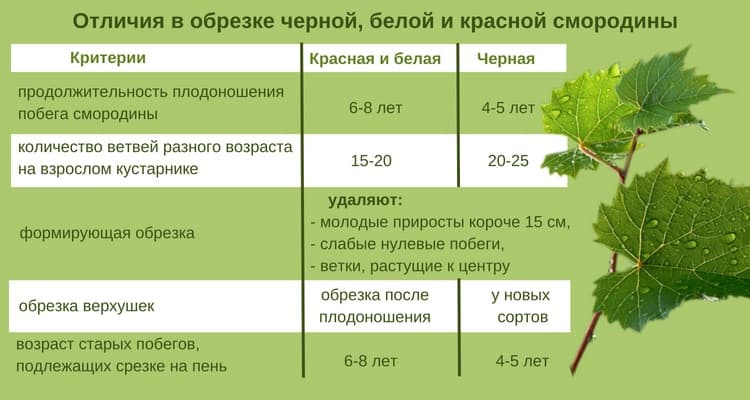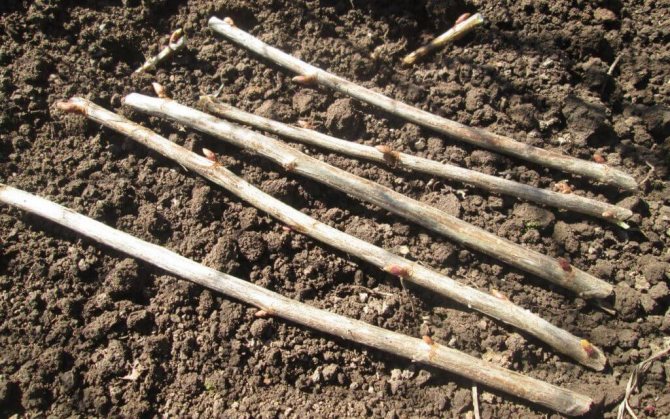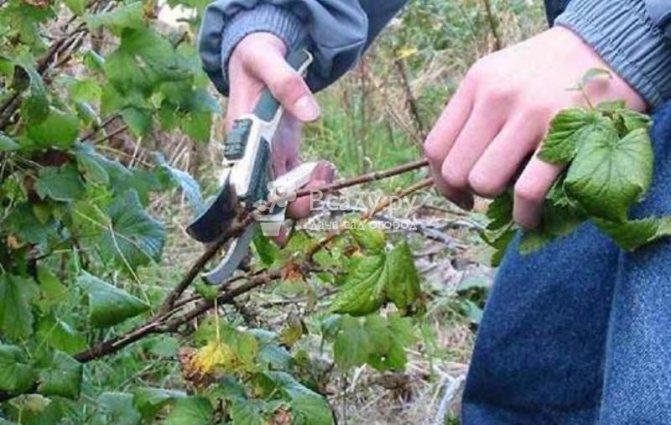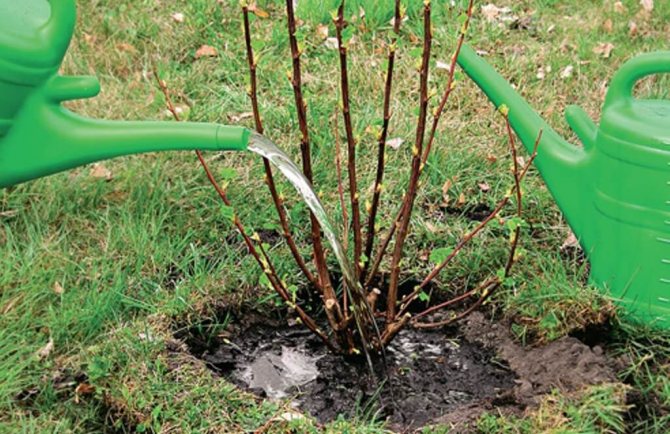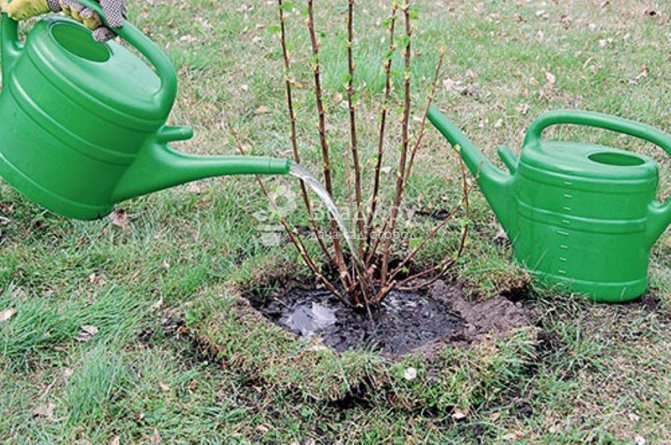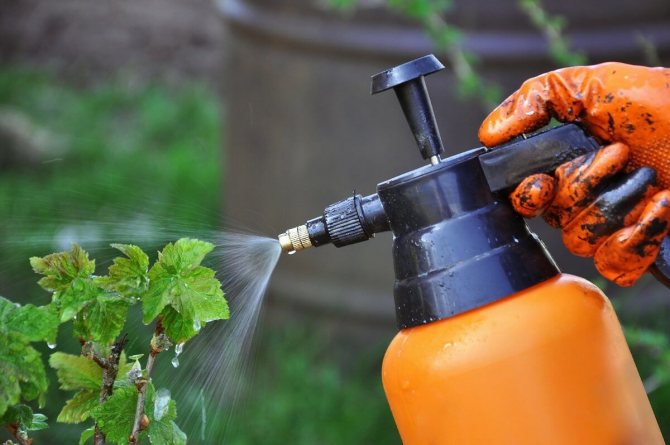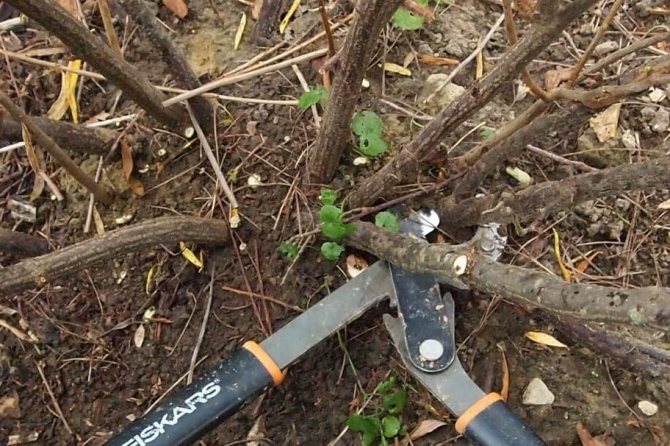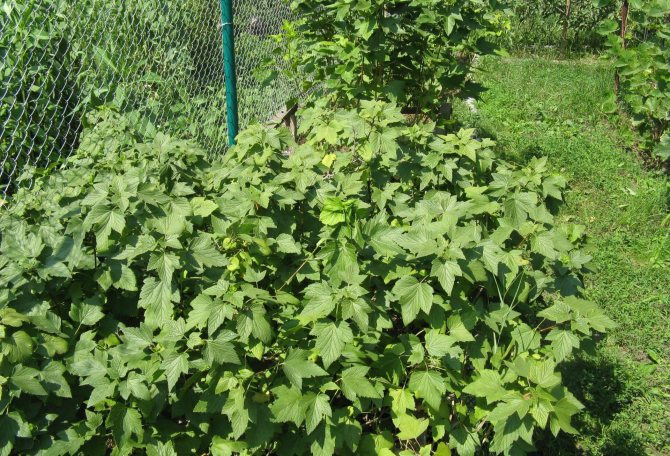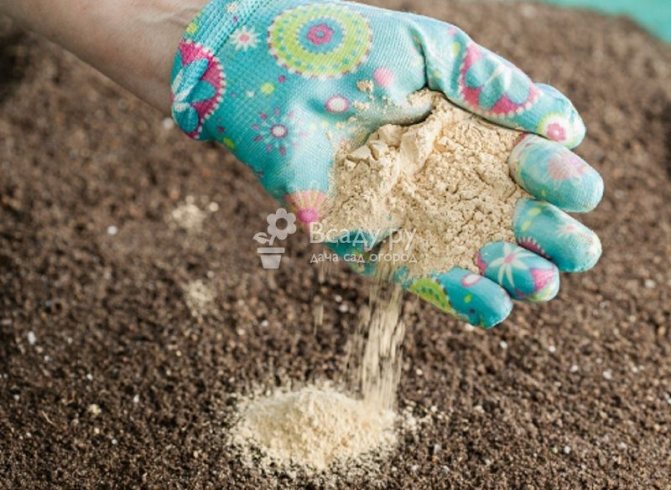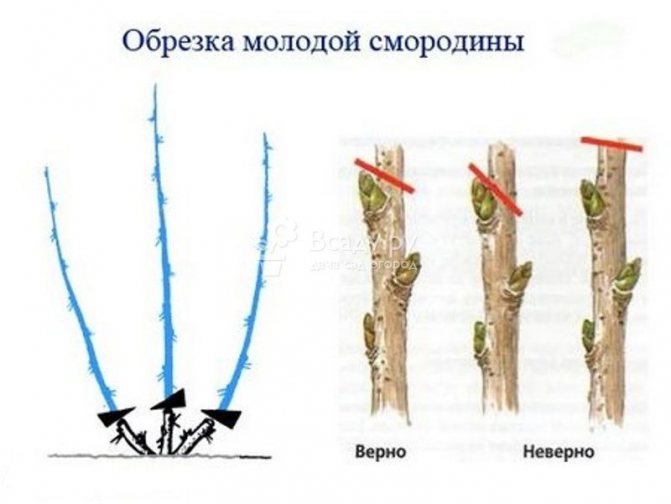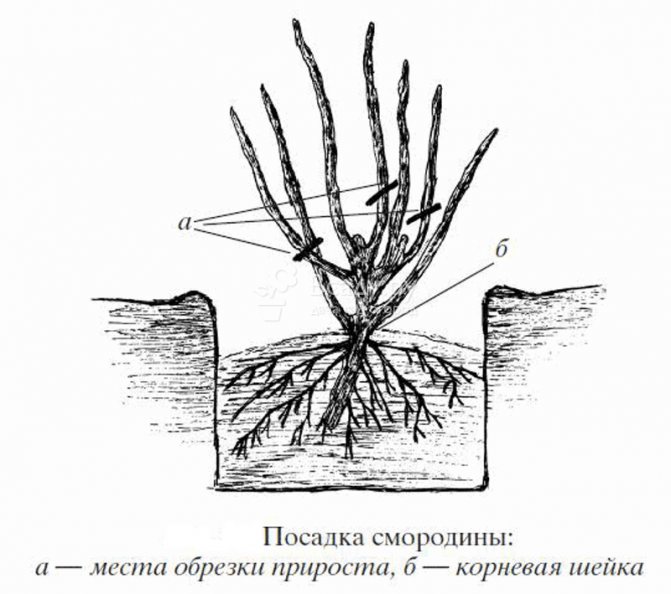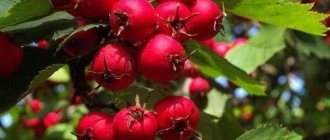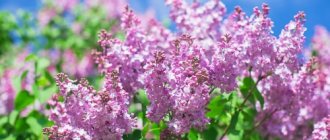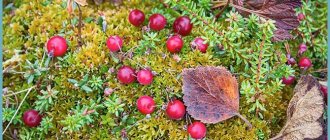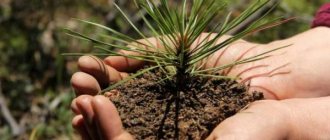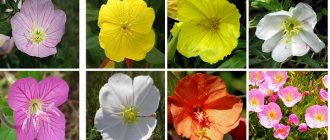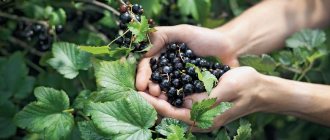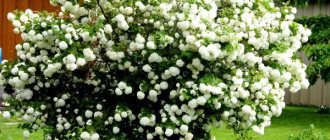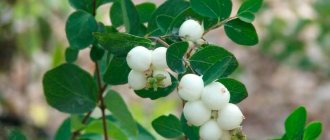Currant is good for everyone: it is beautiful, tasty and does not require special care. Know yourself, remove the weeds, and put the berries in your mouth. For which gardeners love it, growing almost everywhere, from the Kuban to Siberia.
But, you can significantly increase the yield, provide yourself with berries, and sell the surplus. True, for this it is necessary to select suitable varieties, and strictly observe agricultural technology.
Read our article and find out how to surprise yourself and your neighbors with rich currant crops.
There is a rule: "To fix something, you need to know how it works." This also applies to the cultivation of currants: in order to achieve high yields, you need to know the biological characteristics of the plant. There are three types of currants:
- black;
- red;
- golden.
The species are similar in principles of agricultural technology and biological characteristics. As part of the article, we will consider black currants, and we will tell you the nuances of growing red as necessary.
Black currant - planting and care at their summer cottage
Black currants will delight you with a magnificent harvest, planting and caring for which are described in detail in our material. We will help you choose the right place and seedlings, prepare the soil and plant a crop, and also tell you about the features of growing berry bushes throughout the growing season.
Black currant is one of the favorite berries of gardeners. The secret of popularity: in the natural richness of vitamins and undemanding culture to growing conditions. Caring for black currants has its own characteristics, but it will not cause any particular difficulties if you choose and prepare a place for planting correctly, as well as cut and process the crop from parasites and fungal diseases in time.
Pruning black currant bushes in spring and autumn (with video)
Currants, like other berry bushes, bear fruit abundantly and regularly if, along with good care, systematic pruning of the bushes is carried out. The purpose of pruning black currants is to cause the growth of new strong shoots from the underground part of the bush, to increase their branching, as well as the growth of annual shoots on perennial branches, to prevent thickening of the bush, to normalize the yield, and to increase the size of berries.
Black currant pruning is carried out in spring and autumn, immediately after planting. To bring the aboveground part of a seedling with a disturbed root system into conformity, after digging it out of the nursery, each shoot is shortened, leaving 2-4 well-developed buds; the weaker the shoot, the more you need to cut it.
Currant - planting and care in the country
Currants are planted in early spring or mid-autumn. Planting currants in the fall is preferable, since in the spring it is necessary to have time before sap flow begins and the buds bloom, while the soil may not have time to warm up enough and the plant will die.
A sunny place, protected from the wind with a well-drained non-acidic soil (pH value 6-6.5), is chosen for the currants. Fertile light loamy soil is ideal. To reduce the acidity of the earth, add up to 1 kg of lime, chalk or dolomite flour per 1 sq. m.
Deacidification of land for planting currants with dolomite flour
Propagate currants using cuttings or dividing the bush, by separating large shoots with roots from the main trunk.Cultivation of black currants will be successful if you choose two-year seedlings up to 40 cm high, with 3-5 skeletal branches at least 20 cm long, they take root best. Consider how the planting of currants is carried out in stages.
Soil preparation
The selected area is leveled 14 days before planting the seedlings, the rhizomes of the weeds are removed and the soil is left to shrink. After 2 weeks, the site is divided into circles with a diameter of 50-60 cm, which are dug to a depth of 40 cm.The distance between them is maintained at 1.5-2 m, when planting in rows - up to 3 m.
Three quarters of the pit is covered with a bucket of compost or other organic matter. Add 200 g of superphosphate, 60 g of potassium sulfate or 40 g of wood ash. A little black soil is poured on top of the fertilizers so that their concentration does not burn the roots, and then planting is carried out.
Planting black currant
The seedling is planted at an angle of 45 degrees, placing the root collar at a depth of 5 cm. This promotes the growth of basal buds and the further development of a powerful root system. If you plant a seedling directly, then the bush will be formed with a single stem.
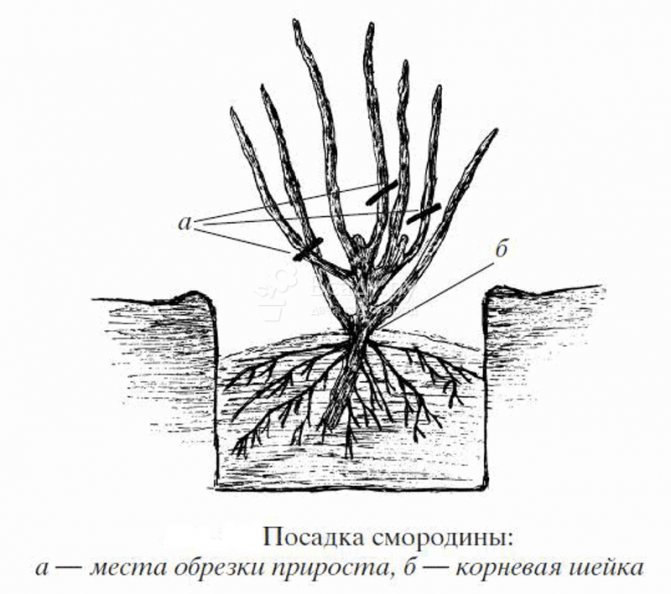
Currant seedling planting scheme
Planting currants ends with watering 5 liters per hole and another 5 liters on a circular hole around it. After watering, it is necessary to loosen the soil: up to 8 cm in depth - directly under the plant, at a distance of 20 cm from it - up to 12 cm. Then the soil is sprinkled with fine peat or humus.
After completing the planting procedure, the seedling is cut at a height of 15 cm from the ground, leaving up to 5 buds on it. The cut branches can be stuck next to the main shoot, sprinkled with water with the addition of Kornevin and covered with a film or plastic container for rooting and engraftment. Pruning stimulates vigorous plant growth.
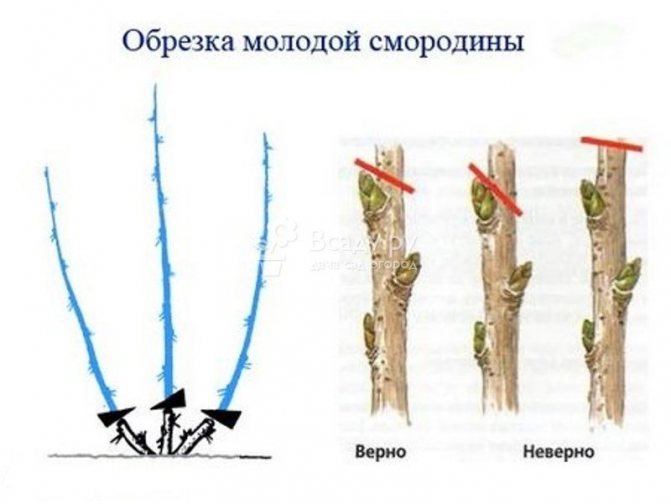

Scheme of cutting currant seedlings after planting
Planting currants in summer video
If the seedlings were not prepared in advance, it is possible to plant black currants in the summer. Most often this is necessary when propagating currants by layering in your garden. This planting is also called deposition or simply breeding. It is performed after the completion of fruiting: for early varieties - in July, and for late varieties - in mid and late August.
Biological features of currants
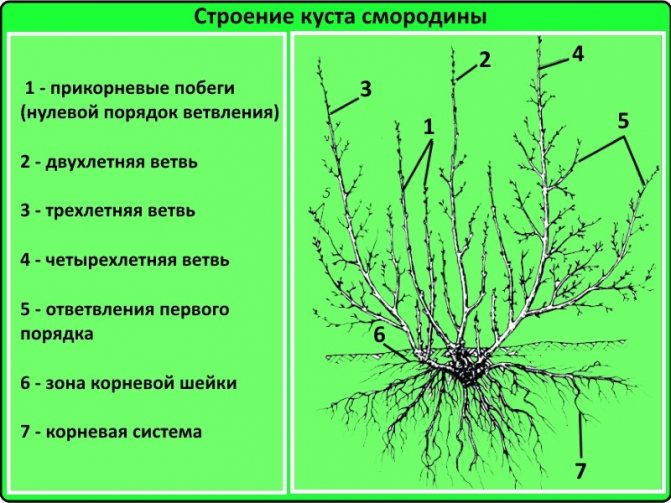

Currant is a perennial shrub whose height does not exceed 1.5-2 m. A feature of the plant is the absence of buds on the roots. Take a look at the image. The growth of basal shoots (1) begins from the zone of the root collar (6). It is in this way that a currant bush is formed, because it does not give growth. The next year, after the emergence of zero-order shoots, two-year branches appear (2), then three-year branches (3).
This feature of the currant must be taken into account when planting a bush.
Root collar
should be about 10 cm below the soil surface.
In this case, many shoots of the zero order appear, the bush is easier to form, and over time it is possible to rejuvenate without problems.
Most gardeners do not know about this, and many Internet resources do not provide such information. Meanwhile, the correct location of the root collar of the bush is the key to the strength of the plant and a bountiful harvest.
Features of the development of stems
Currants differ in the nature of the development of the stem. Conventionally, the plant can be divided into three groups:
- Many annual branches, but few perennial ones. In the currants of this group, the fruits live for a year or two, then they die, and new ones are formed in their place. After 4-5 years, new fruit branches stop forming and yield decreases. The situation can be corrected by pruning branches older than 4 years "per ring". The most famous variety of black currant of this species is September Daniel.
- There are few basal shoots, but perennial stems branch well. Fruits on such bushes live for a long time, on average 4-5 years, therefore the bush bears fruit for 6-7 years.If the branch is older, the fruits on it become smaller, the yield decreases. The solution to the problem is the annual cutting of 2-3 perennial branches. This stimulates the growth and development of basal shoots, the bush is renewed in a timely manner, the yield does not decrease. A variety of this type is Pamyat Michurin.
- In this group, the varieties occupying an average "position" between the previous ones. In other words, both the number of basal shoots and the degree of their branching have an average value. The fruiting period is 5-6 years. It can be increased by shortening the branches to the first strong bud. One of these varieties is Success.
In the picture you can see how fruits are formed on branches of different ages in black currant.
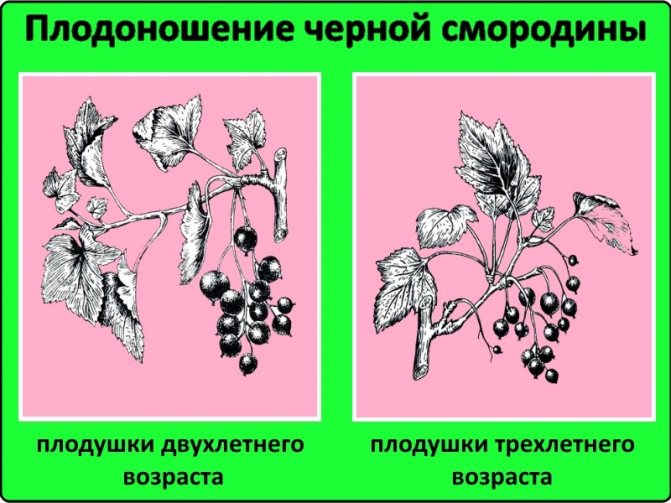

As for the red currant, it has more durable fruits.
Subject to agricultural technology, red currants give a greater yield than black currants for 8-10 years.
Pruning is mainly aimed not at rejuvenating the bush, but at reducing the degree of thickening.
Currant morphogenesis
If you are scared and decide to quickly scroll through this item - we hasten to reassure you. We will not tell you all the biological subtleties.
But knowing the timing of the morphogenesis of currants and what it affects will help to take the necessary measures in a timely manner to increase yields.
Scientists have found that the process of laying a crop begins a year before fruiting. This year, the yield will depend on how the currant developed in the last season. And it is morphogenesis (kidney differentiation) that is the most important stage.
The timing of the process is different, depending on the following factors:
- type and variety of currants;
- air temperature;
- the amount of precipitation;
- the number of sunny and cloudy days;
- other conditions.
It was found that in dry and sunny weather, morphogenesis proceeds faster than in cloudy and rainy ones. According to the timing, we can only say for sure that the beginning of kidney differentiation is from July 12, and the end is in the spring of next year. In some years, morphogenesis can begin in early August.
Surprisingly, it is during this period that most inexperienced gardeners calm down, and limit themselves only to weeding and waiting for the harvest. Meanwhile, efforts must be redoubled and the observance of agricultural practices must be monitored.
Currant bushes should receive the required amount of nutrients, water, light. It is necessary to pay attention to the condition of the leaves.
Disease-damaged or underdeveloped leaves do not provide high-quality photosynthesis. The significance of this process for plant life is known from the school course in biology.
Black currant: growing and care
In order for berry bushes to develop well and bear fruit, it is necessary to provide proper care for black currants throughout the growing season.
Spring care for black currants
Before the appearance of buds, all old, dried or diseased branches are cut to a healthy stem, the wounds are covered with garden var. Nitrogen fertilizers are applied (up to 80 g of ammonium nitrate or 50 g of urea per plant) for two-year-old bushes. After feeding, the soil is dug up and watered.
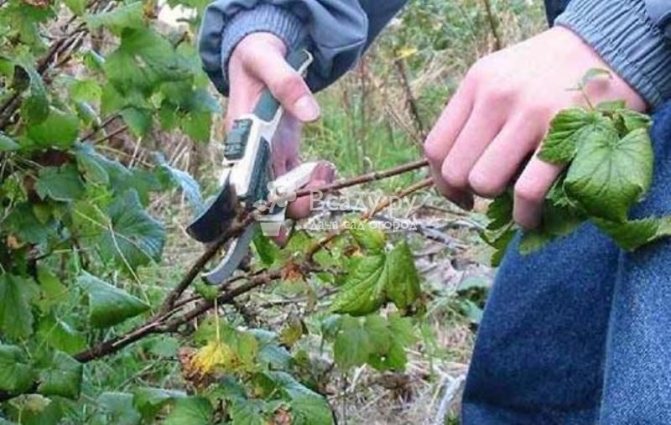

Sanitary currant pruning
At the time of the formation of the ovary until the beginning of June, watering is carried out at the rate of up to 30 liters of water per bush, every 5 days. This is done in the evening using warm water (10-15 degrees Celsius), at the root. For watering, it is recommended to make circular grooves 15 cm deep at a distance of 30 cm from the seedling. Water ingress on leaves can lead to the development of powdery mildew.
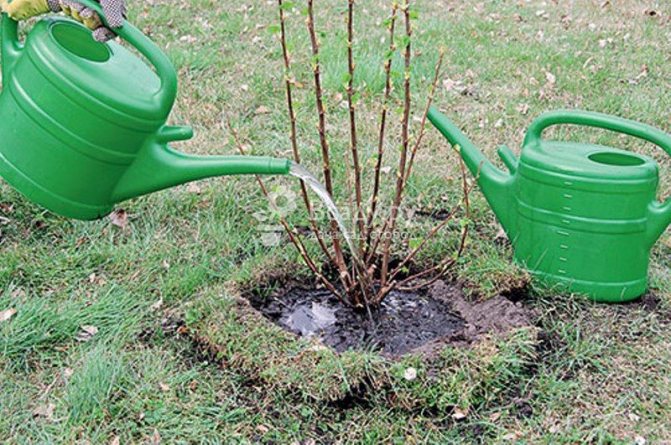

Watering a young currant bush in spring
To improve the moisture resistance of the soil, mulching is desirable. You can use peat, straw or newspaper. It is important to do this during the green cone and bud formation phase to prevent moisture loss.
Summer currant care
In the first half of June, organic feeding should be carried out: up to 15 kg of humus per 1 bush, or liquid feeding (bird droppings diluted with water 1:10).
When there is no rain for a long time, timely watering is especially necessary. Usually a bucket of water a week is enough. Watering currants in summer becomes more frequent from late June to mid-July during the ripening of berries, and is done every 5 days.
Currant care in June also includes pinching the young stems of the tops by 2 buds to increase the number of side shoots. This procedure promotes the development of new shoots. The timing of the pinching is postponed to a later date in order to delay the fruiting of the bush.
During the ripening of the fruits, foliar dressing is applied: mixing 5 g of potassium permanganate, 40 g of ferrous sulfate and 3 g of boric acid. Dissolve them separately, and then mix together in a 10 L bucket of water. Spraying is carried out in the evening or on a cloudy, windless day.
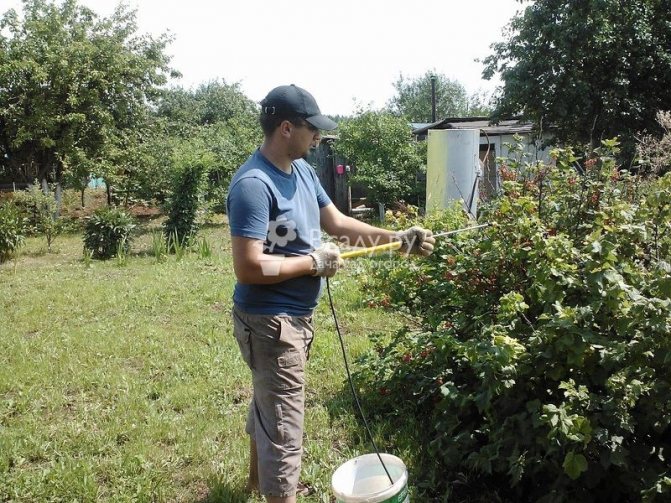

Spraying and caring for currants in summer
After fertilizing or watering, it is recommended to remove weeds and gently loosen the soil up to 5 cm so as not to touch the root system of the plant located at a depth of 30 cm.The row spacing is loosened to a depth of 10 cm.
Harvesting berries must be done by the piece, and not plucked in a bunch. This is less likely to damage the plant. Watering and fertilization is completely stopped two to three weeks before harvest.
Care for currant bushes in autumn
After completing the harvest, starting in mid-August and throughout September, watering is carried out once a week, with loosening the soil to a depth of 5 cm. In dry autumn, preparation for winter includes increased soil moisture - half a meter deep.
At the end of September, it is necessary to introduce organic matter (4-6 kg of poultry droppings), or feed them with minerals: 20 g of potassium sulfate and 50 g of superphosphate. In any case, 200 g of wood ash is added when fertilizing. After that, the soil is dug up and mulched to increase fruiting for the next year.
Feeding currant bushes with organic matter
Before the onset of the first frost, it is necessary to prune underdeveloped and weak shoots, as well as those that grow in the middle of the bush and thicken it. Poorly developed young branches are also subject to removal, of which only 3-4 of the strongest are left. An adult bush usually consists of 15 shoots from different years of life.
How can currants be propagated
Have you bought a currant, got your first harvest and thought about how to propagate the bushes? Use a vegetative method, it is he who allows you to preserve the parental qualities of the plant.
- Woody cuttings.
- Green cuttings.
- Green apical cuttings.
- Layers.
Each method has its own nuances, we will tell you about them, and you choose the technique at your discretion.
Propagation by woody cuttings
The method impresses with its simplicity and worthy results. The main thing is to strictly adhere to the technology. Read carefully and memorize.
- Select the bottom or middle part of the annual branch. The length of the harvested cutting should be 15-20 cm, thickness - 6 mm. The number of buds on the handle is 4-5 pcs. Material procurement time is the second half of September.
- Place the cut material in a container with wet sand and place it in the basement. If possible, the cuttings can be kept under the snow, this method of wooding is preferable.
- Treat the cuttings with root growth promoters before planting in spring. Use "Kornevin" - 5g / 5l or heteroauxin - 100-150g per liter of water. Keep the cuttings in the solution for a day, while they should be 2/3 immersed in the liquid. The air temperature should not be lower than 230C.
- Transplant the cuttings into potting soil. After about 12 days, seals will appear on the bottom, which signal that the cuttings can be planted in a permanent place in the open ground.
- While the cuttings are in the pots, prepare the soil at the planting site. To do this, add 8 kg of compost, 40 g of superphosphate and 15-20 g of wood ash for each square meter. Dig up and moisten the soil.
- Cuttings should be planted in early spring at an angle of 450, leaving one bud on the surface. This planting contributes to the rapid growth of the root system. The distance between the cuttings in a row is 10 cm, the row spacing is 25 cm.
- An important condition is abundant irrigation after planting in the amount of 30 liters of water per square meter.
A good result is obtained by planting cuttings under a film. To do this, spread the material over the garden bed, dig in the edges. The landing pattern with this method is 8x15 cm.
To get rid of weeds that can grow under the film, sprinkle soil between the rows in summer.
With this method of propagation, the bush is obtained with one stem. To get several branches - pinch the top as soon as it grows 8 cm. You will get 2-3 shoots.
Propagation by green cuttings
One of the simple and reliable breeding methods, which is suitable for both a novice hobbyist and an experienced gardener.
Cutting is carried out as soon as the desired shoots reach a length of 20 cm. This usually occurs by mid-summer, but the timing for each region is different. To have a clear idea of the method - see the schematic image.
- Select branches that are 2 years old with developed second-order shoots (1).
- Cut the cuttings according to the scheme, the lower leaves can be removed.
- Remember that there should be a small patch of 2-year-old wood on the bottom.
- Plant in the ground (3), the distance between the cuttings is 5 cm, the spacing is 15 cm. The planting depth is 3-7 cm, but the longer the cutting, the greater the value.
- Water abundantly, about 3-4 times at knocks. In case of heat - 5-7 times.
Further care of cuttings consists in timely weeding, loosening and fight against diseases.
An interesting way is used by some gardeners, we hasten to share it with you. The technology is the same, but the cuttings are grown not outdoors, but indoors under plastic wrap stretched over arcs.
Gauze is pulled from above to protect the plant from sunburn. Before closing the bed, it is watered abundantly.
Now you can rest for 15 days. Watering the cuttings is carried out by means of condensation, and the increased air temperature contributes to the rapid rooting of the cuttings. A month after planting, remove the film and continue to grow young bushes in the usual way.
Propagation by green apical cuttings
The method is rather complicated; special equipment is required. For its implementation, a greenhouse or greenhouse and a fogging installation are required. This technology is available to specialized gardens and nurseries, so let's talk about it briefly.
Cuttings are planted in a specially prepared substrate consisting of soil and peat in a 1: 1 ratio. Then, using the installation, a fog is created, the humidity of the air must be at least 90%. With this method, the cuttings take root after 2 weeks.
Reproduction by layering
The method is simple, it is used often. It is based on the ability of currants to "put down" roots from shoots. The technology is simple:
- In early spring, bend annual shoots to the ground, fix them with wooden spears, as shown in the figure.
- As soon as the shoots grow 10 cm, make the first hilling 4 cm thick. The soil must be moist.
- After 20 days, repeat the hilling, the layer thickness is 10 cm.
- In the fall, cut off the shoot from the base of the bush, select the strongest shoots and transplant to a permanent place. Do not touch weak shoots, let them grow.
The survival rate of cuttings is high, you can easily propagate the variety you like.
Diseases and pests: prevention and treatment
With proper care, currants rarely get sick, there are such diseases: terry, anthracnose, gray rot, powdery mildew.Of the parasites, kidney and spider mites, fruit sawfly, glass, and moth are dangerous for her.
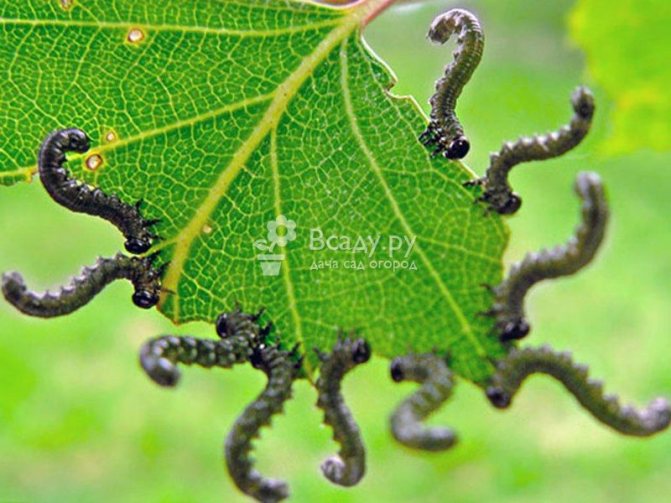

Moth caterpillars on currant leaf
To protect the plant from diseases, preventive measures are used. In the spring, before the buds awaken, the bushes are watered with hot water at a temperature of plus 80 degrees. Celsius, at the rate of 3 liters per 1 plant for treatment against pests and diseases. They also carry out timely sanitary pruning of the bushes in order to prevent thickening and regularly dig up the soil to destroy pests.
Also, until the spring swelling of the buds, the currants and the soil under it are treated every 10 days. To do this, use a 1% solution of Bordeaux liquid, 2% solution of Nitrafen or Karbofos. These drugs are also used when signs of diseases or parasites are detected, in which case caring for black currants in summer includes spraying 3 weeks before picking berries. This will help protect the crop from septoria, brown spot, glassfly and aphids.
During flowering and the appearance of the first leaves, additional treatment with fungicides is necessary: Alirin-B, Gamair, Prognoz, Topaz, Glycoladin - from rust and anthracnose.
You can read about how to get rid of a kidney mite on currants in our article.
Classification [edit | edit code]
Types [edit | edit code]
The most famous are the following types of currants: black ( Ribes nigrum
) and red currant (
Ribes rubrum
) - both grow wildly in Northern Europe and Siberia. The difference between them, in addition to the color of the berries, is that black currant leaves and berries are extremely fragrant from the essential oil, which is contained in special glands that cover the lower surface of the leaves especially densely. Various syrups and liqueurs are also made from blackcurrant juice (fr. Cassis). Gooseberries are bred in large quantities (
Ribes uva-crispa
) [syn. Ribes grossularia], which also belongs to the currant genus. Several hundred varieties are known among horticultural crops. The berries of many other cultivated species of currants are also eaten, but in small quantities they are collected from wild-growing shrubs. Some species (eg Ribes aureum, Ribes floridum and Ribes sanguineum) are bred as decorative flowering plants.
In total, more than 190 species are known [3], some of them:
Preparing currants for winter
Proper care of black currants includes preparing for winter. The soil under the bushes is weeded and the fallen leaves are removed.
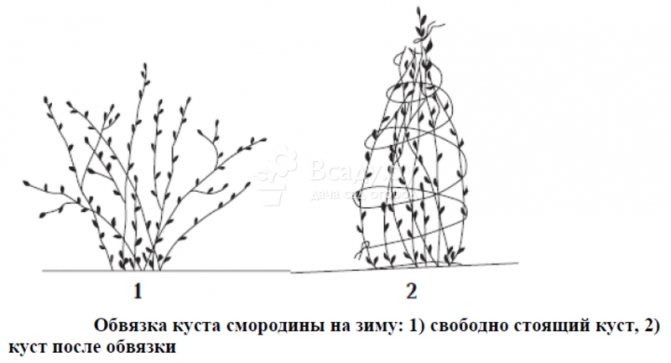

Scheme of strapping a currant bush for the winter
After the onset of the first frost, the bush is pulled together in a spiral upward with a rope, at the top clamping it with a clothespin. The ground is covered with mulch. After a large amount of precipitation falls at the base of the bush, a snow pillow 10 cm high is made, and then the bush is completely covered with snow.
Growing currants on the site will only bring pleasure, since the culture is not demanding and bears fruit perfectly. Carefully monitor the behavior of the plant so that you always know what it needs, do not forget about timely watering, fertilizing and preventive treatments. Then the black currant, which is taken care of according to all the rules, will thank you with a magnificent harvest and a large berry.
Blackcurrant recipes, harvesting it for the winter
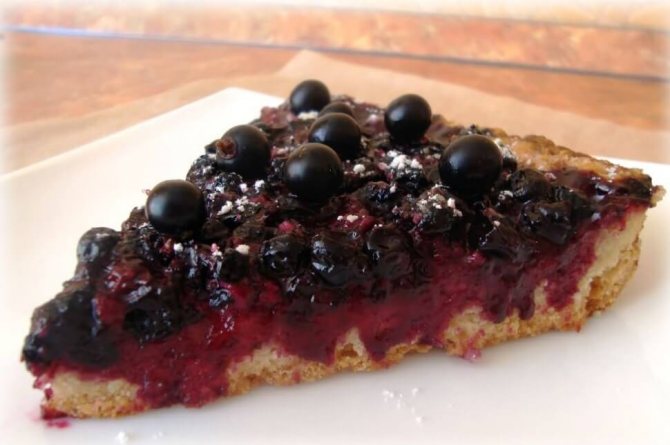

A lot of healthy products can be prepared from black currants: homemade wine, pie filling, preserves, jams, compotes, fruit drinks and jellies. There are plenty of recipes for harvesting black currant, it can be frozen and preserved.
The berry is a universal storehouse of vitamins and microelements, it contains a huge amount of vitamin C. Blackcurrant recipes for the winter should be aimed at preserving the berry in its original form and preserving its vitamins to the maximum.
Blackcurrant wine recipe
Making homemade blackcurrant wine is not difficult, for this you need to know a simple recipe for making a wine drink.
Sorted, but not washed, currant berries are crushed to a state of porridge, water is added to them (into two parts of berries, three parts of water) and one part of sugar in syrup cooked in a water bath and cooled to room temperature. The mixture is placed in a fermentation glass container, filling no more than two-thirds, since the berry fermentation is active. The bottle with the liquid is covered with a gauze towel and left in a dark place for a week, stirring the contents several times a day. Fermentation of currant wort is carried out until its clarification.
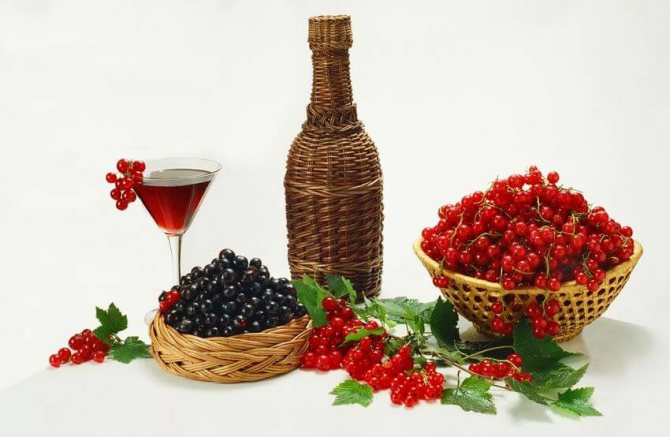

The fermented wort is filtered through a saucepan or cheesecloth, the liquid is tested for sugar, and then poured into glass bottles with a water seal, filling the container halfway. Young wine is tasted every week, and sugar syrup is added as needed.
The full fermentation phase lasts about two weeks. The end of fermentation will be indicated by a water seal, it will not let bubbles. After that, the drink is filtered to get rid of the sediment, poured into containers and tightly closed. Store young wine in a dark place, avoiding heating the drink.
Blackcurrant jam and pie filling
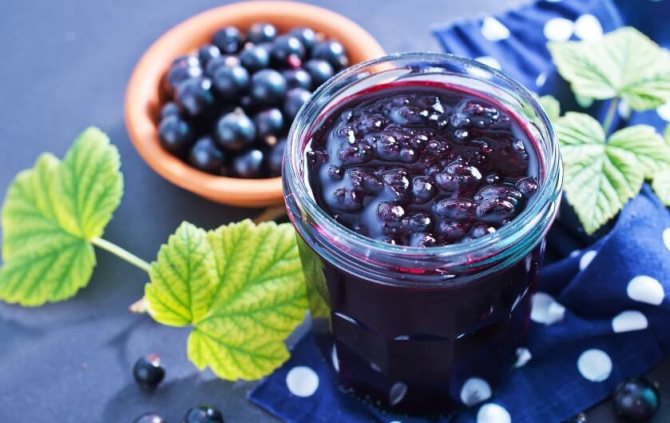

Black currant is also good in jam. Extraordinarily tasty jam is obtained from black currant. The berries are sorted, washed, placed in an enamel container, covered with sugar (per kg. Berries, kg. Sugar), pour in 100 ml. water. Stirring occasionally, the jam is brought to a boil, and then poured into jars for conservation.
Black currant compote
The washed berries are poured into a saucepan with water, brought to a boil over low heat, sugar is added to taste during the boil. Preservation of blackcurrant compote for the winter is carried out according to the classical preservation technology. Currant berries are poured into sterilized jars, water with sugar is brought to a boil and poured over the berries, the jars are twisted, turned upside down and wrapped for 12 hours.
Blackcurrant tincture
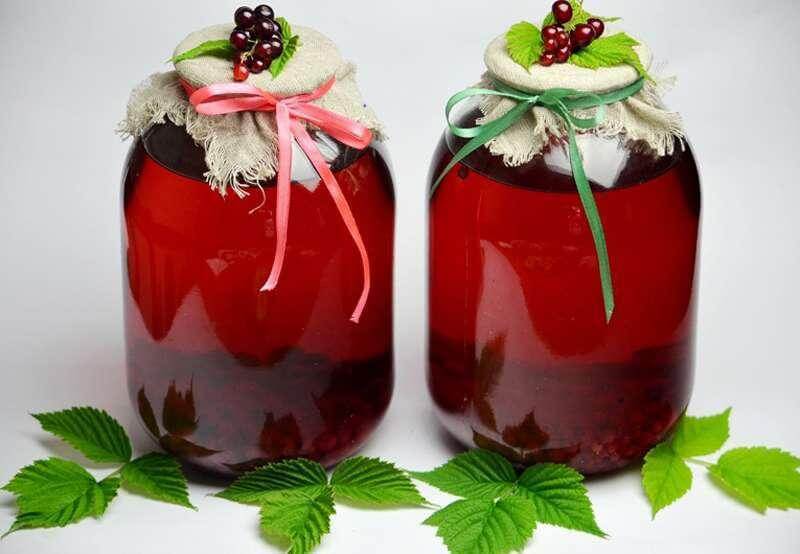

Blackcurrant tincture, quick and easy to prepare. The berries are kneaded, transferred to a glass container with a wide neck, poured with vodka and insisted in a dark place for about two weeks.
After filtration, the tincture is stored in a glass container at a temperature not higher than +10.
Blackcurrant jelly
I grind the currant berries to a puree state, pass through a gauze napkin or sieve. Then sugar is added to the mass and boiled for 5 minutes. over low heat. After, the jelly-like mass is laid out in a sterilized glass container and hermetically closed.
Black currant: planting and care in the open field.
Black currant is the most common berry in the gardens and vegetable gardens of compatriots. It is a perennial shrub from the gooseberry family. The berry is appreciated for its taste, beneficial properties and ease of self-cultivation.
Planting and caring for black currants in the open field it is not difficult, since the shrub grows to a height of 1.5 m, and yields a crop already in the second year after planting. Breeders have bred many varieties of shrubs that differ in taste, shape, size of fruits and brushes, and ripening time.
Varieties of different types of currants
Check out the main modern currant varieties of different types. You can enlarge the photo by clicking and view everything in detail
The varieties listed below are approved by VNIISPK and zoned.
Smolyaninovskaya currant
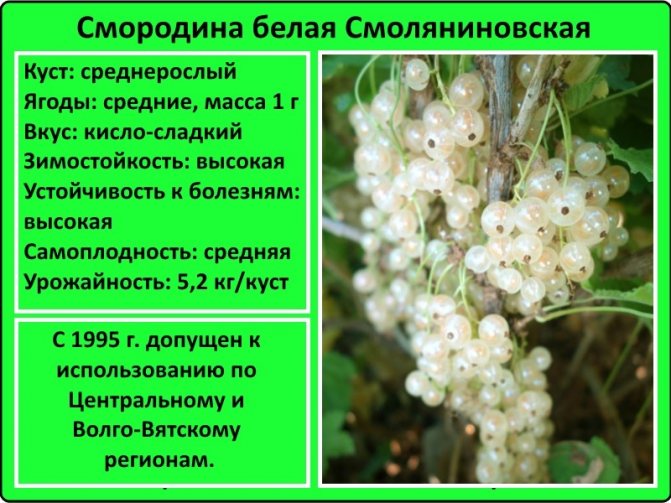

One of the few modern varieties that have white fruits. As a result of selection, scientists have obtained a shrub that not only possesses such unusual berries, but also has a high resistance to diseases.
The Smolyaninovskaya variety is easy to care for, it is not afraid of frost, the berries are juicy, with a characteristic sourness.
At the same time, a good yield was achieved: if you follow agricultural techniques, then you will receive up to 5 kg of harvest from one bush!
It is possible to grow this variety in open ground in the Urals, the Volga region and in the central regions of Russia.
Currant varieties Karaidel
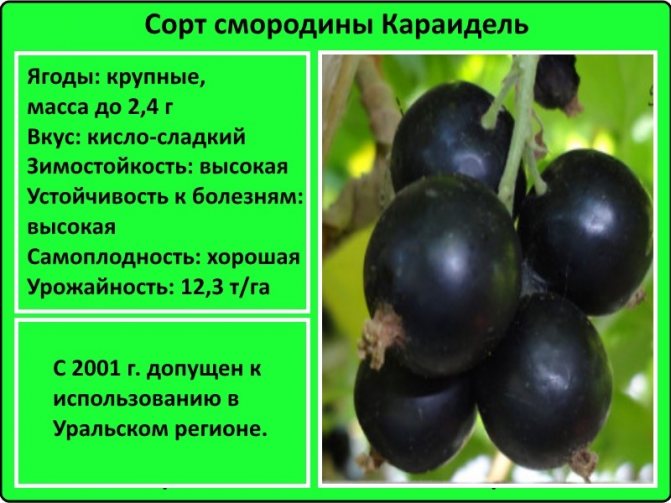

The variety is intended for cultivation in the Urals, but is also suitable for other regions of Russia. The bush is compact, it is not difficult to care for it.
Of the amenities - a low degree of infection by fungal diseases, winter hardiness.
The berries are large enough, fragrant, with dense pulp. There are few seeds, you can safely use it for making jams.
The only drawback is that it requires regular pruning due to the strong growth of basal shoots.
Dutch red currant
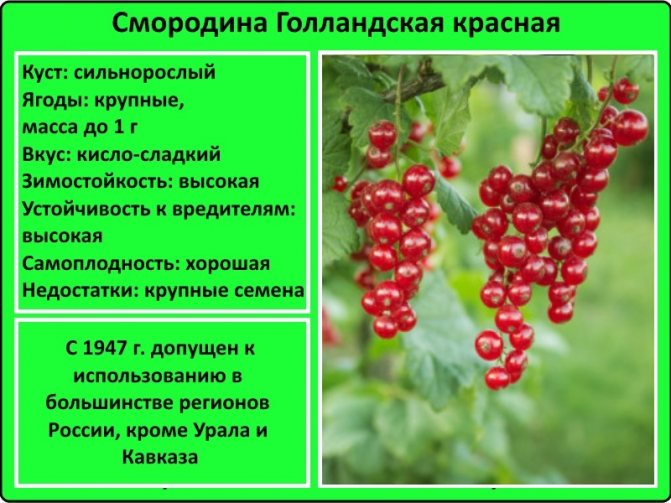

One of the oldest currant varieties. It is known that it was grown in Europe as early as the 17th century.
The currant bush is high, the crown density is increased, but at the same time it is not very spreading.
Fruits are dense, with a characteristic sour taste. The seeds are dense, large, therefore the main purpose of the variety is processing and conservation.
Dutch red currant has excellent resistance to fungal diseases. The plant is suitable for growing outdoors in the North-Western regions of Russia, but it does not take root well in the Urals or Kuban.
Currant Krasa Altai
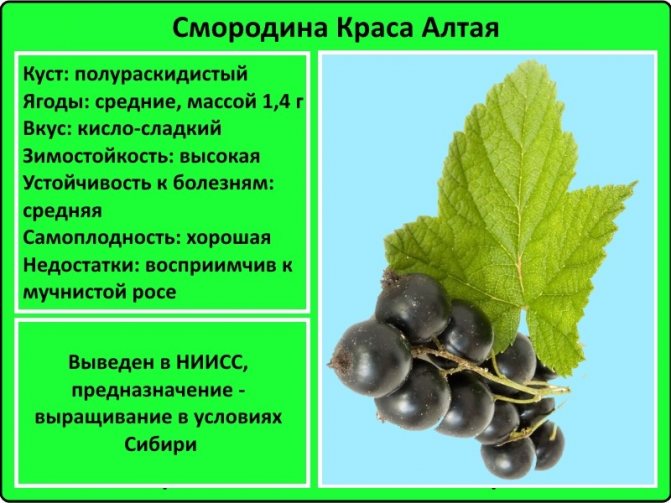

Are you looking for a variety of currants that can be grown outdoors in the Urals and Siberia? Pay attention to the Beauty of Altai.
The plant is susceptible to powdery mildew and some pests, but, with timely preventive treatments, it will delight you with yield.
The variety perfectly tolerates severe frosts, self-pollinates. A pleasant addition - the berries are firmly adhered to the branches and, after ripening, do not crumble.
At the same time, the taste of currants is pleasant, with a slight sourness. Suitable for food both fresh and for preservation.
Currant Ural beauty
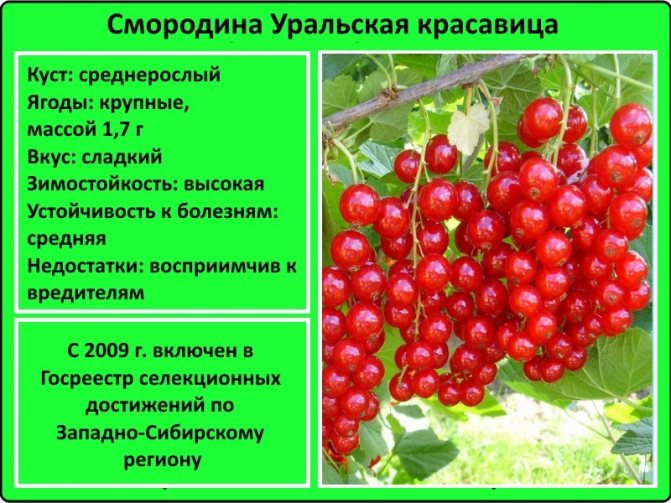

Despite the fact that the variety is zoned for Western Siberia, it is successfully grown in the Urals, in the Moscow region and in other regions of Russia.
The variety attracts gardeners with its high yield and large, sweet berries. The Ural beauty tolerates severe frosts well, and the medium-sized bush facilitates the process of caring for the plant.
Among the disadvantages, one can single out a weak resistance to some pests. You can fight them, and successfully. Subject to the recommended agricultural techniques, the variety will delight you with regular and abundant harvests.
We have described for you only some of the modern varieties of currants. If you are interested in earlier breeding, which were cultivated in the USSR, see the table.
| Variety | Ripening period | Berries | Winter hardiness | Yield |
| Belarusian sweet | Middle | Black, large, weighing 1-1.2 g | High | 2.5-3 kg / bush |
| Grape | Early | Black, large, weight 1.3 g | Excellent | 3-6 kg / bush |
| Leningrad giant | Middle | Black, with a thin skin, weighing 1.2-2.2 g | Good | 3-5 kg / bush |
| Stakhanovka Altai | Average | Black, dull, do not crumble, weight 0.7-0.9 g | High | 1.5-3 kg / bush |
| Chulkovskaya | Early | Red, small, weighing 0.4 g | Average | 4-6 kg / bush |
| Sugar red | Early | Juicy, sweet, weighing up to 1 g | High | 4 kg / bush |
| Versailles white | Middle | Yellow, transparent, large, weight up to 1.5 g. | Average | 3-4 kg / bush |
Remember that you need to buy currant seedlings of any kind in nurseries. Buying at the market or from a "familiar gardener" is fraught with unpleasant consequences. The fact is that some pathogens and parasites of currants have an incubation period of 1-2 years.
Outwardly, the seedling may look healthy, but after a while the disease will manifest itself. When buying planting material in nurseries, there is no such risk.
Types and varieties of black currant
Gardeners give the greatest preference to varieties of currants, which ripen early and have large berries. The most common varieties include:
In addition, there are other subgroups of numerous varieties, where they distinguish:
- large-fruited varieties include varieties: Krasa Lvova, Chereshnevaya, Dobrynya, Comfort, Sanuta and others;
- varieties of early ripe currants: Yarinka, Overture, Golubichka, Dikovinka, Exotic, Dachnitsa, Sibylla and others;
- dessert varieties include: Maria, Perun, Centaur, Venus, Slastena and others;
- the sweetest varieties are: Pearl, Raisin, Black Boomer, Legend, Lazy.
There are other types of berries - these are red and white currants... They differ in color and are considered one culture. Red currant has become known in Russia since the 15th century, white - at the beginning of the last century.
Application
The shrub has a dual purpose. It is grown as a fruit and berry crop and for decorating streets, parks and squares.
As a fruit and berry crop
The harvest of golden currants is used for winter harvesting. They make jam, jam, make compote, freeze. They make excellent homemade wine.
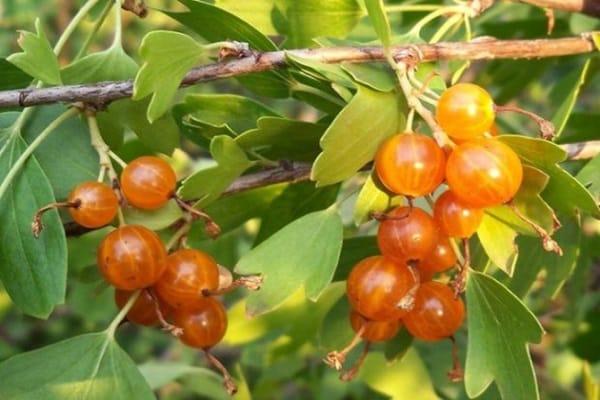

Use in landscape design
The high decorativeness of the shrub allows the use of golden currants in the design of streets, squares, parks. Their bushes are decorated from spring to autumn. Long arched branches reach 2 m in height. In the spring, they are covered with clusters of golden flowers for three weeks.
In summer, the branches are sprinkled with a scattering of shiny black berries. In autumn, the leaves turn purple. Gardeners form picturesque hedges from golden currants. A green fence decorates the landscape, protects from noise, dust, wind.
Currant care in spring
In the spring, gardeners resume caring for their garden, including currants - they prepare them for summer fruiting. Question, how to care for currants, worries all summer residents.
Pruning in spring leads not only to the formation of a bush, but also guarantees a high yield. Currants bear fruit branches of three to four years of age. If they are older, there will be no harvest, and cutting off old branches leads to the growth of new shoots that bear fruit.
Pruning is also necessary for the bush as a sanitary treatment, when sick, insect-infected branches are cut out.
If the currant bush is young, it is necessary to shorten the shoots to increase its bushiness. To do this, it is recommended to leave 2-3 buds on each shoot, then new branches will grow by the fall.
Every year, it is necessary to remove zero shoots from the bush, leaving 4-5 strong branches, and pinch the tops, leaving only a few buds. This is how fruits are formed - these are fruit twigs on old shoots.
Currant pruning in spring, video:
Shrub formation
The golden currant is well formed, quickly recovers after cutting thanks to dormant root buds and underground stems. Pruning begins at the time of planting the bush. Several strong shoots are left on the plant, which are shortened to 4 buds. All weak branches are cut out. An adult shrub should have 20 to 30 branches of different ages. If different varieties grow on the site, then it is necessary to be guided by the formation of the bushes by their specific characteristics. We talked about pruning red and white currants earlier.
Video about growing currant hedges.
Pruning stages by year:
- In the second year, all shoots are pruned at 13, weak and damaged ones are completely removed.
- For 3 years, you need to cut off a new growth, leaving from 3 to 6 strong basal shoots.
- In the fifth year, you need to thin out the bush by removing the shoots growing inward. For the convenience of harvesting, all branches that lean to the ground are cut off.
- Rejuvenation is carried out - pruning of old shoots from the age of 8 years. If the bush is more than 10-12 years old, it can be rejuvenated by cutting it into a stump. The procedure is useful for those fruit perennials in which the harvest is concentrated at the edges of the crown.
- Sanitary trimming is carried out annually. All frozen, dry and damaged branches are subject to removal. All young shoots that thicken the center of the bush are mercilessly cut out.
Feeding currants
After all, the shrub has the ability to take all the most useful from the ground, therefore feeding currants in spring promotes a rich harvest in summer.
Top dressing of bushes is carried out in compliance with the following principles:
- If the plant is only a year old, then it is enough to apply nitrogen fertilizers: 15 g of urea, 15 g of ammonium nitrate and 37 g of calcium nitrate per bush.
- The currant bush, which is several years old, will be helped by organic fertilizers. In this case, it is necessary to dilute the manure and 2 teaspoons of urea in a bucket of water. The whole mixture is thoroughly stirred and 2 liters of the resulting composition are added to each bush. At the end of the work, it is recommended to water the bush well with water.
- The second feeding is carried out two weeks later, when the berries begin to set. Here you should pour humus under the currant bushes with the addition of 2 teaspoons of potassium sulfate.
- Then, after another 2 weeks, the third feeding is carried out: spraying with a urea solution, where 2 teaspoons of the composition are taken for 10 liters of water.
- The last feeding of currants is carried out in the fall so that it will survive the long frosty winter. For the last feeding, a mixture of superphosphate and potassium sulfate is taken, 6 teaspoons per 30 liters of water. The resulting composition must be watered under the bush, and then covered with humus and wood ash.
Watering and feeding
Gold currant care includes moderate watering, sanitary and formative pruning. In many ways, agricultural technology is simpler than growing the more popular black and red currants. The plant is not demanding for watering. For a comfortable existence, there are enough rare moisture during the drought period. The rest of the time, the plant will have enough natural precipitation. 2-4 buckets of water are introduced into the trunk circle. Periodically, the soil around the bush is loosened and cleaned of weeds.
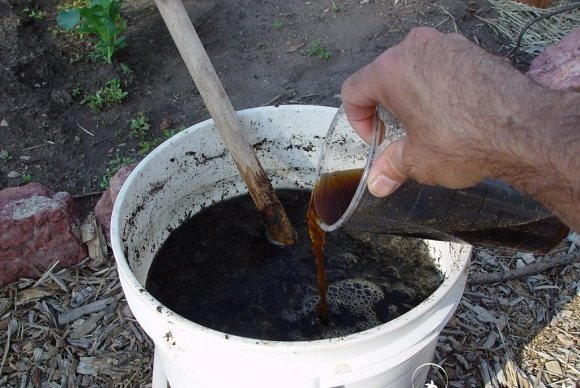

Prepared watering solution
In spring and on time, flowering, a fruiting perennial absorbs more nitrogen, therefore, nitrogen or complex fertilizers are used for feeding. Urea, nitroammophoska will do. 25-30 g of fertilizer is applied to the trunk circle. After harvesting, add 25 g of potassium nitrate and 35 g of superphosphate. In the fall, you can impose rotted manure on the near-trunk circle (every 2-3 years).
Golden currant bushes can hibernate without shelter. It is enough to mulch the soil with peat and dry mullein. Shoots frozen in a harsh winter quickly recover after sanitary pruning.
Spring treatment from diseases and pests
Currants must be processed in the spring from pests and diseases. The most common currant diseases are powdery mildew, which affects leaves and shoots, rust, anthracnose fungus, terry (viral disease).
Regular treatment with a Bordeaux mixture or a solution of wood ash will help get rid of the anthracnose fungus. For the prevention of diseases, it is necessary to carry out treatment as soon as the snow melted.
The most famous pests are:
- Leaf sawfly that destroys leaves. Special solutions of plants that contain phytonicides help from it: garlic, wormwood, tomatoes, horseradish, nightshade.
- Leafy gall aphid - manifests itself in burgundy swellings on the surface of the leaves. Here it is recommended to treat it with tar soap or garlic infusion, and the biological product Fitoverm will also help.
- Shoot aphid - leads to leaf curling. As a preventive measure, in the spring, before the buds swell, in order to destroy the eggs of aphids, it is necessary to treat the shrub with an 8% nitrafen solution. Chlorophos helps well with the addition of karbofos - 2 g of solution per 10 liters of water.
- Spider mite, due to which the leaves turn yellow and dry. It appears in dry years, therefore, as a preventive measure, frequent and abundant watering of the bush is required. When a tick appears, the shrub can be treated with a solution of karbofos, colloidal sulfur and phosphamide.
- A kidney mite that contributes to the death of the kidneys.To prevent damage to the entire shrub, it is necessary to remove already affected shoots and buds, which should then be burned in a place safe for their area. After the presented actions, it is necessary to treat the bush with a solution of colloidal sulfur, taken in a proportion of 10 g of a component per 10 liters of water.
- The kidney moth is a kidney-eating insect. You can destroy it with a 0.1% solution of Aktara or an infusion of dry mustard, tansy, celandine and tomato tops, taken in equal proportions (take 1 kg of the mixture for 10 liters of warm water).
You can start the presented treatment method immediately after winter, while the buds have not yet begun to swell. Boiling water should be poured into a container and poured through a strainer onto currant branches from a distance of 10 cm.
The water for processing must be at least 60 degrees Celsius, but not more than 80 degrees, otherwise a burn will occur, and a low temperature will not bring a positive result.
It is also important to clean and burn leaves and debris left over from the fall - pests can live in them. Then you should dig up the aisles and around the bushes - this will strike a blow to the accumulation of larvae, spores and pest nests.
Diseases and pests, characteristic of the species, the fight against them
Diseases on currants are rare, but they do happen. In troubled years, the bushes are exposed to the invasion of pests.
Common spider mite
The pest weakens the plant, with a strong infection, the leaves dry on the bush, the berries ripen later. Signs of spider mites on golden currants can be seen in May before flowering. The leaves on the bushes turn from green to brown or whitish. You can see the ticks from the back of the sheet plate.
Destroy the pest with "Karbofos" (50%). The bushes are sprayed after flowering. Leaves damaged by insects are cut off and burned. They dig up the earth in the near-trunk circle. Instead of "Karbofos" use garlic infusion, sulfur preparations.
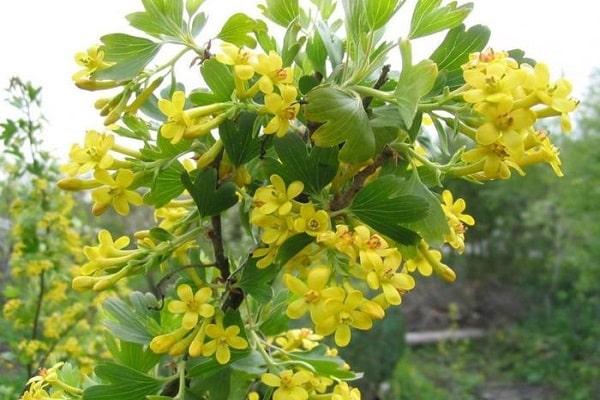

Kidney currant mite
A very dangerous pest. You can find out about the infection by the signs of its vital activity. They appear in early spring and during the growing season:
- swollen kidneys;
- deformed apical leaves.
There are several methods of dealing with a tick. In early spring, the infected shoots are determined by the buds, cut out and burned. During flowering, currant bushes are treated with a solution of colloidal sulfur.
Big currant aphid
The fact that aphids attacked the golden currant bush is recognized by the twisted, wrinkled leaves. Turning them over, they see small green insects on the back of the leaf plate. They suck out the juice, carry the infection.
See also
How to grow currants on a trunk with your own hands step by step, planting and care, Read
To destroy the pest, the bushes are treated with:
- solution of "Karbofos";
- "Nitrafen" (3%).
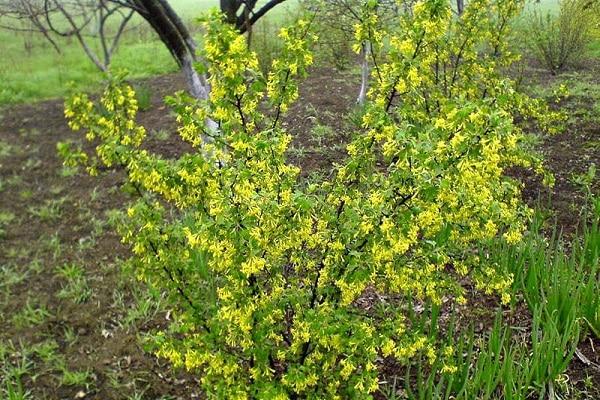

Anthracnose
The cause of the disease is a fungus. Small brown spots on the leaves are the first symptoms of the disease. They turn brown over time, dry up, fall off. The infection primarily affects tender young branches, peduncles, petioles. Anthracnose significantly reduces the winter hardiness of golden currants.
Ways to fight:
- the soil and branches are treated with "Nitrafen", a 3% solution is used, the processing time is spring-autumn;
- in the summer, the leaves are sprayed three times with colloidal sulfur (1%), the processing time before and immediately after flowering, the third time after picking the berries;
- control the cleanliness of the trunk circle, pull out weeds, remove leaves, loosen the soil.
Septoria
This disease has a second name - white spot. The leaves are affected by the infection. Septoria symptoms:
- at the initial stage, small (2-3 mm) rounded brown spots;
- the affected areas turn white, a brown border appears around them;
- pycnidia are formed on the leaves in the form of small black dots.
Leaves crumble from a diseased bush, its yield drops, growth slows down. Apply methods of treatment as for anthracnose.
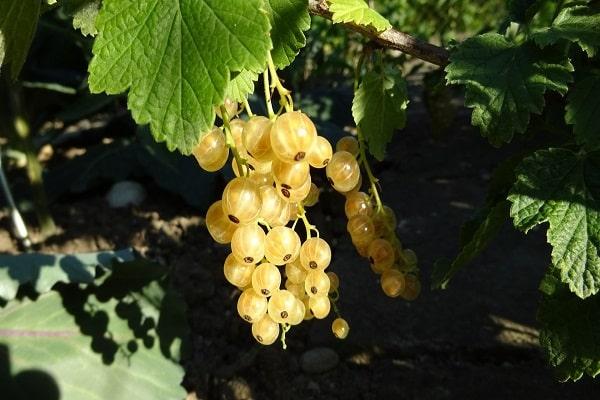

Goblet rust
The cause of the disease is a fungal infection.It affects berries (70%), leaves (80%). Damp weather contributes to the epidemic. Control measures as for anthracnose.
Planting currants
It is best to plant black currants in the fall, but if for some reason this did not work out, then the process can be postponed to spring. Planting currants in spring carried out as soon as the snow melted.
The soil should be fertile and not swampy, the presence of high groundwater is unacceptable - in this case, the roots may die from excess moisture.
For planting, you should dig a hole 50 cm wide and 40 cm deep, put organic fertilizers on the bottom, premixed with the soil. Before planting the seedling, 10 liters of water should be poured into the pit and only then the shrub should be placed in the pit without damaging the root system.
How to grow a golden bush
It is not difficult to breed a golden variety in the country. Although for good fruiting in the garden, it is worth planting 2-3 seedlings. The more of them, the better the pollination.
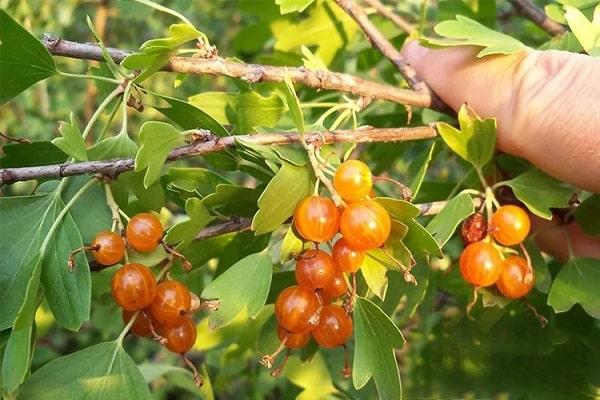

Suitable climate
All varieties of golden currants are acceptable for the Moscow region. This species can adapt to extreme climatic conditions. The climate of the middle zone and the South of Russia is suitable for growing and harvesting. The shrub freezes, dies in a frost of -40 ° C. Varietal currant can withstand southern heat and drought.
Optimal timing
In autumn, seedlings of golden currant are planted in the garden from September to October. At least 1-1.5 months should pass before frost. In the spring they are planted after the ground thaws.
Site selection and disembarkation scheme
Golden currant is remarkable in that it grows and bears fruit on any soil. It can be planted near a fence, a building. Sites with light shading are more suitable for planting, but the shrub also tolerates bright sun and shade.
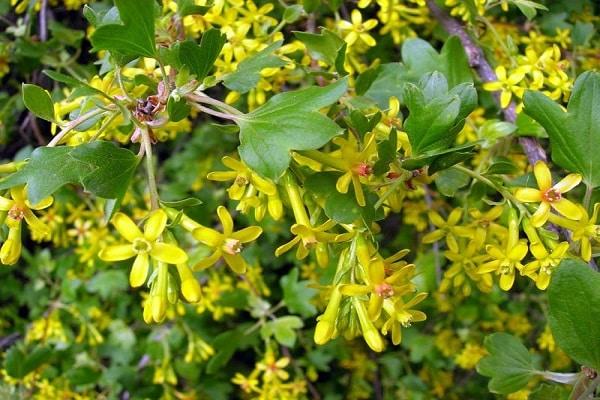

Landing scheme, requirements for the landing pit:
- width - 0.5 m;
- depth - 0.5 m;
- soil mixture for backfill consists of humus (1 part), garden soil (1 part), ash (1 tbsp.), superphosphate (200 g);
- the distance between the planting pits is 2.5-3 m.
See also
Measures to combat rust on currants, treatment with drugs and folk remediesRead
Reproduction of black currant
An important question, how currants reproduce, worries all gardeners. There are 3 ways to propagate black currant: cuttings, dividing the bush and layering.
Cuttings
Reproduction of currants by cuttings in spring begins with the preparation of planting material. Cuttings are taken from the main root shoots or annual branches that come from the bush.
The cut is made with a pruner 1.5 cm above the bud, because the root system will subsequently develop from it. For breeding, a trench with a depth of one shovel bayonet is being prepared in the fall. Compost and manure are laid in it, and in the spring, as the snow melts, when there is still a lot of moisture in the ground, cuttings are planted.
It is recommended to plant cuttings at a distance of 10-15 cm, leaving passages of 40 cm, so that it is more convenient to take care of it. At the end, the soil surface should be covered with peat or humus to retain moisture. By autumn, the cuttings should form into young bushes, and then they can be transplanted to a permanent place.
Autumn planting of black currant cuttings, video:
Layers
Reproduction by the presented method is carried out in the spring by dropping young two-three-year-old cuttings into shallow dug grooves. A mixture of compost, humus and peat should be placed on the bottom of them, and the layering should be fixed with metal or wooden pins and sprinkled with earth.
By the fall, the cuttings will release roots, they can be separated from the mother bush and planted in a permanent place.
Dividing the bush
Here it is required to expose the shrub to digging up the root system. This is done carefully so as not to damage the roots. Also, several shoots are carefully separated by hand and planted in a neighboring, pre-prepared pit, according to all the basic rules for planting seedlings.
Black currant bears fruit every year, delighting gardeners with a bountiful harvest. And its large sweet berry is recognized as the most useful in the world.
Did you like the article? Show it to your friends:
Features of culture reproduction
You can grow seedlings from seeds. This is the most common breeding method for golden currants. The procedure is simple, but lengthy in time:
- seeds are taken from ripe berries;
- for 2 months they are sent for stratification in a cellar, where the temperature is not higher than 4 ° C, they are stored in a container with wet sand;
- in the fall they are sown in the ground.
You can propagate golden currants vegetatively:
- layering;
- dividing the bush;
- green cuttings.
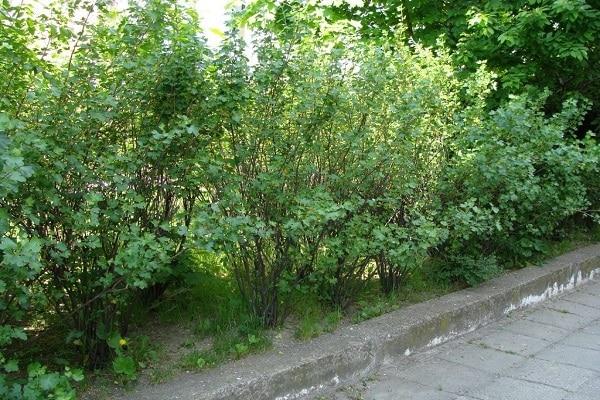

Currant - planting and care in the open field
Currant is a favorite berry of many. Its main advantage is the high content of vitamins and minerals, which are so necessary for every person. Currant - planting and care in the open field - an important issue that worries all summer residents. Although today a bush of red or black currant necessarily grows on every site, not many people know how to properly care for it in order to get a good harvest.
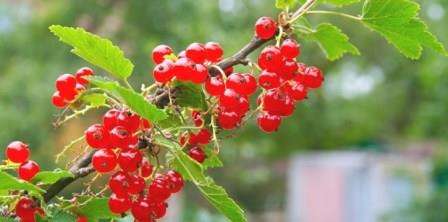

Currants need good care
Characteristics and advantages of the species
Gold currants are not as common in Russian areas as black and red currants, but the shrub is definitely noteworthy. With proper care, such currants grow up to 2.5 m in height. It is extremely resistant to adverse conditions: it withstands drought, heat, frost, rarely gets sick and is attacked by pests. Thanks to this, many varieties are grown even in cold regions.
The currant got its name not for the color of the berries, but for the bright golden flowers. Fruit color can be orange, purple, black, pink.
The shrub has pale green foliage with a yellow tint. It blooms beautifully and profusely, from the end of May it is covered with yellow flowers, filling the space around it with a sharp but pleasant aroma. Yellow currant is an excellent honey plant. Flowering begins later than black and lasts 15-20 days. During the specified time period, the flowers manage to get pollination by bumblebees and evade frost, so the harvest is guaranteed every year.
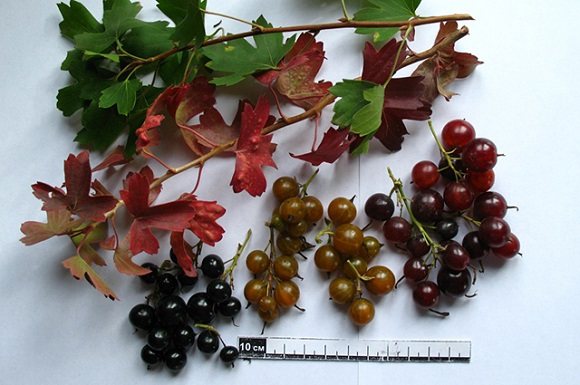

The advantage of the golden look is its high yield (from 5 to 15 kg). The berries do not crumble, you can collect them in one go. The species is cross-pollinated, therefore it is recommended to grow at least 3 varieties on the site. Fruit sizes vary depending on the variety. On average, the weight of the berry is 1.5-3.5 g.
Summer recipes:
- Cooking amber apricot jam with slices: a classic recipe, assorted with gooseberries and oranges, cooking in a slow cooker.
- Raspberries frozen with sugar: ways to preserve berries in containers, bag, mashed potatoes.
Thanks to the dense peel, the crop is stored for a long time and is perfectly transported. The taste can be described as sweet and sour, tart, honey, with nutmeg or blueberry notes.
Golden varieties begin to bear fruit actively 3 years after planting.
The greatest yield is given by branches of 5-7 years of age. The advantage of berries is in the high content of vitamin B and carotene, but at the same time, the fruits cannot boast of the richness of vitamin C, like black currant berries.
Currants - when is the best time to plant in open ground?
Very often you can hear such a problem - an adult currant bush was planted, but the plant began to hurt and gives a minimum amount of harvest or does not give it at all. What is the reason? This is due to the fact that already at the very first stage - landing, some mistakes were made. When is the best time to plant a currant bush?
The most optimal and suitable time for this is early autumn. During the winter period, the plant will have time to get sick, get used to the climate and harden, so by the spring it will wake up strong and healthy.If the autumn is warm, then the planting of the bush can be extended until mid-October, but it is important to do this before the first frosts begin. Why? If the root system of the currant does not have time to take root properly, the plant will not survive the winter and will die.
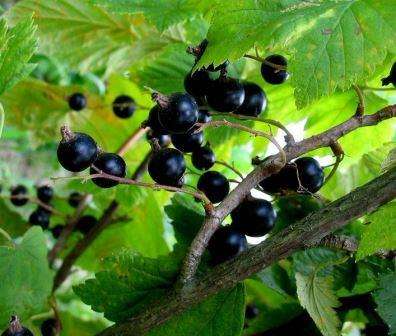

An important role is played by the choice of a suitable place in the summer cottage for planting currants. It should be sunny, warm, without drafts and shade. If possible, it is advisable to give preference to the lowland, not the hills, since the plant loves moist soil. After the rains, all the water will drain into the lowland, which will provide the bush with good moisture. Shade is a dangerous environment for currants. Having planted it there, you can forever forget about a good harvest, since the plant is very sick there and grows very poorly.
Currants are a highly growing bush, therefore, when planting, you must adhere to a certain pattern. The distance between the bushes should not exceed three meters, only this way the branches will not interfere with each other and create a shadow. To plant a plant, you need to remember the following points:
- The soil should be as nutritious and fertilized as possible. To do this, you can mix soil, peat and mineral fertilizers. Acidic soil is a danger to currants, therefore experts recommend pouring a small amount of fluff on the bottom.
- Ash is an organic and very useful fertilizer. Therefore, when planting in the hole, you can add one glass of ash.
- The size of the hole must fully correspond to the size of the root system. If the roots are large and the hole is small, the plant may not start and die.
- Before planting, fertilizers are poured onto the bottom of the hole and filled with water.
- The seedling sits slightly at an angle. Why? In this position, the development of new roots is stimulated, and the seedling itself takes root better. After the hole is covered with earth and trampled down well.
When planting is complete, you should cut off the top of the bush, leaving only a few buds on it. Three is best, but if the plant is weak, 6.
Botanical description [edit | edit code]
Morphology [edit | edit code]
Shrubs with alternate, mostly palmate-lobed leaves.
Flowers are arranged in clusters. The flower bed is concave, fused with the ovary and passing along the edges into 5, usually greenish sepals. There are also 5 petals, all free. The number of stamens is the same. The ovary is unilocular, polyspermous. There are two columns. Flower formula: ∗ K 4 - 5 C 4 - 5 A 4 - 5 G (2 - 4) <4-5>; C_ <4-5>; A_ <4-5>; G _ <(2-4)> >. The flower structure is unstable [4].
Biological features [edit | edit code]
Currants, like gooseberries, are propagated by cuttings and layering; cuttings are usually cut in the fall, after the leaves have fallen, from strong bushes, under the very eye, then they are put in the cellar for the winter and planted in the spring as soon as the ground thaws, in a shady place. In warm climates, cuttings are planted in autumn.
Reproduction by herbaceous layers is carried out in July, after cutting the bark.
Planting currants is best done in August in beds or ditches filled with a mixture of soil and manure. After planting, if the weather is dry, watering is done 2 times a week, at least 1 bucket per bush. The soil surface is covered with manure and a layer of straw.
Pruning (in spring) consists in shortening young branches by 5-6 eyes and removing old branches. Each bush should have at most 10-15 branches of various ages. Old branches must be removed, because the largest berries are obtained on 3-5-year-old branches. Older branches can only be left on boles.
Usually, currants are bred in the form of a bush, by pruning young plants at a level of 20 cm, but sometimes red currants (but by no means black), for the sake of appearance, are driven out in a half-stem or standard form (the first has a trunk up to 50 cm in height, the second - up to 1 m). The latter form is removed by grafting (copulation) on American yellow currants (Ribes aureum pursh
) or, in rare cases, black currant. In the northern regions of the country, it is dangerous to display a bole higher than 70 cm.
The use of currant bushes in landscape design
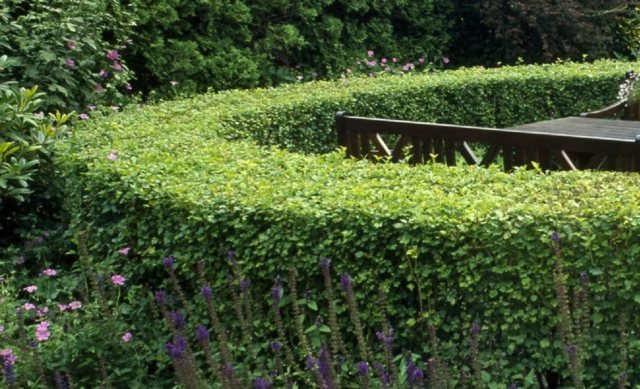

A currant hedge is easy to create with your own hands, and it looks quite impressive
Currant bushes are an excellent material for hedges. They can be used for the following purposes:
- as the heart of the landscape composition. By focusing on it, it is easy to give the landscape the desired structure;
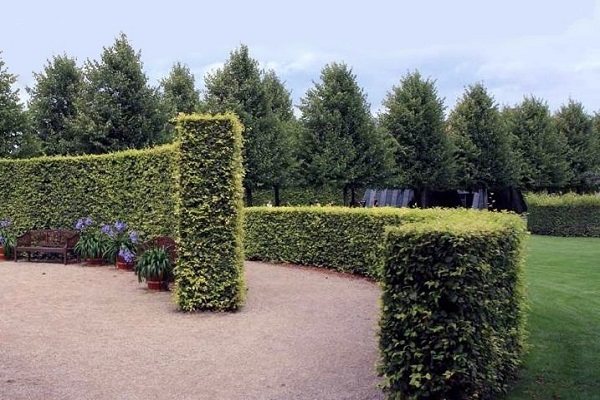

- as a planting divider - this will allow you to unobtrusively create the necessary boundaries for other plants, this technique is especially appropriate when creating alpine slides;
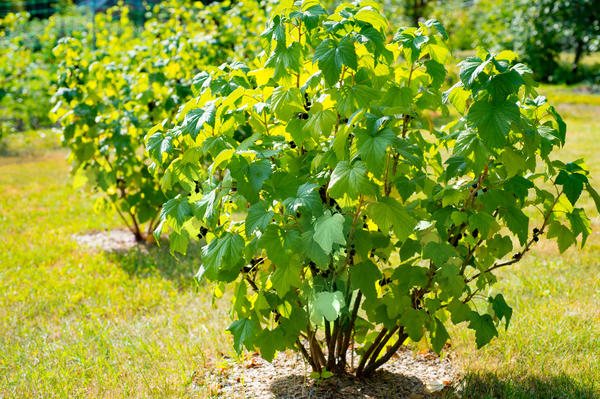

- as a decorative element to hide a fence and other fences;
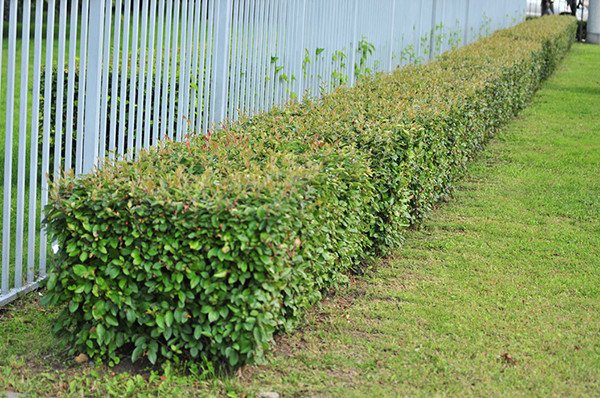

- for zoning space, protecting it from cold and prying eyes.
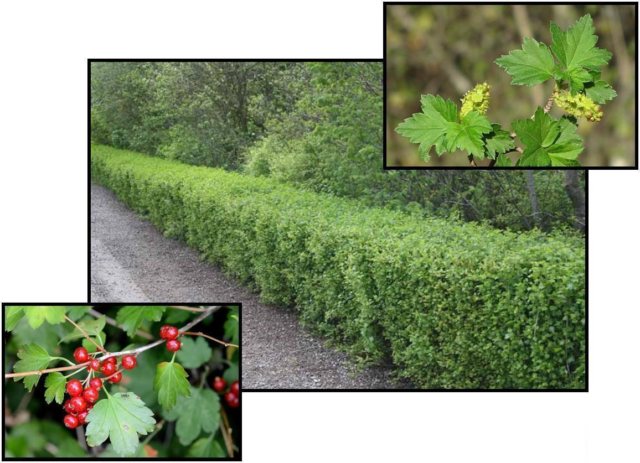

A currant hedge can be given any shape, the shrub easily tolerates pruning and is not picky about care.
Paths framed by currant bushes, arches, arched elements, straight lines of fences or bizarre compositions look interesting in landscape design - in the design of which there are almost no restrictions.
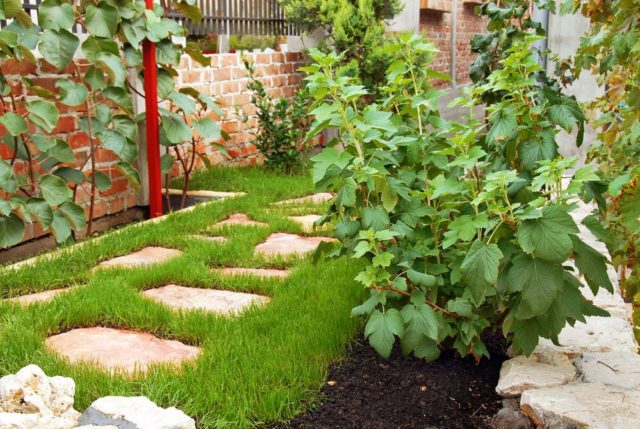

The shrub looks equally advantageous in any composition and gives the site a special color Attention! If it is necessary to create a continuous hedge, then the plantings are placed very tightly or according to the chess principle (in two rows), at the rate of 3 seedlings per 1 p / m - for a single-row planting, and 5 seedlings per 1 p / m - for two-row hedges.
Advantages and disadvantages
Benefits:
- Undemanding, resistance to diseases and pests.
- Frost resistance - the plant can withstand 30-degree frosts and even more. Frost usually affects only the very tops of the shoots.
- Resistant to heat and drought. Leaves are not damaged at temperatures of 40-42 ° C.
- Resistantly tolerates temperature extremes.
- Flowering starts late, after the risks of frost return.
- It can grow in any soil. Grows well in all areas, including steep slopes.
- High productivity.
Disadvantages:
- Due to lack of moisture or nutrition, the ovaries may crumble.
- Wet separation of fruits.
- Fruits crack when overripe and at high humidity.
- Young leaves contain a glycoside, a hydrocyanic acid derivative. Because of this, the leaves are not allowed to be used for brewing tea.
- Often, young shoots do not finish the growing season before the onset of frost, and therefore freeze slightly.
The choice of planting material
The key to the full development of currants is a combination of factors, including the choice of location, adherence to the rules of agricultural technology, and a suitable variety. But at the initial stage, a high-quality seedling is important.
In order for the cultivation of currants to be crowned with success, planting material is chosen without visible damage to the root and stems, with a healthy appearance. The number of skeletal roots ranges from 3 to 5, the presence of developed fibrous roots is mandatory. They must be processed and kept moist.
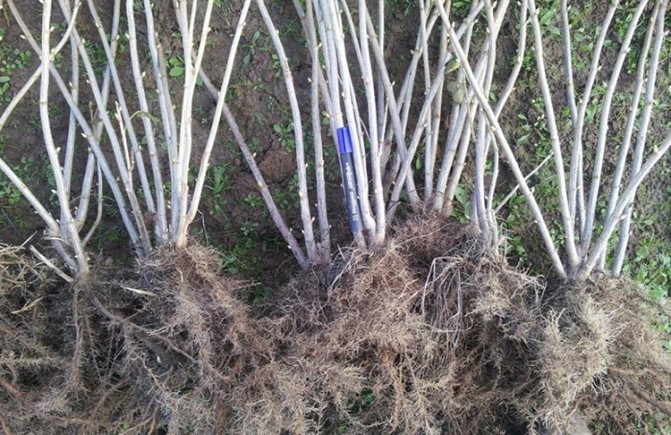

The aboveground part of the seedling includes developed one- and two-year shoots 25-40 cm high, flexible, light gray in color. The optimal age of the planting material is 1-2 years, perennial specimens take root worse. Normal bud size is a sign of a healthy shoot. Their swelling indicates a kidney mite injury. A seedling with leaves is not suitable for planting.
It is recommended to pack the roots in a moist substrate or wrap them in a cloth soaked in water before transporting them. Transport or storage without suggested protection measures will destroy the root system.
Landing features
Currants are quite unpretentious - it is not difficult to plant it, and take care of it too. It is known that in many summer cottages, it grows by itself and at the same time gives a very good harvest. But still, it is better to protect the shrub from unfavorable conditions and give her everything she needs. As always, cultural planting activities begin with choosing the most appropriate location.
Appropriate place
First of all, the area for currants should be well lit so that shading is present for no more than half of the daylight hours. If the topography of the site is uneven, then you can plant shrubs on the southern slopes, taking into account the prevailing winds. It is good if there is wind protection, especially for those varieties that tend to shed berries as they ripen.
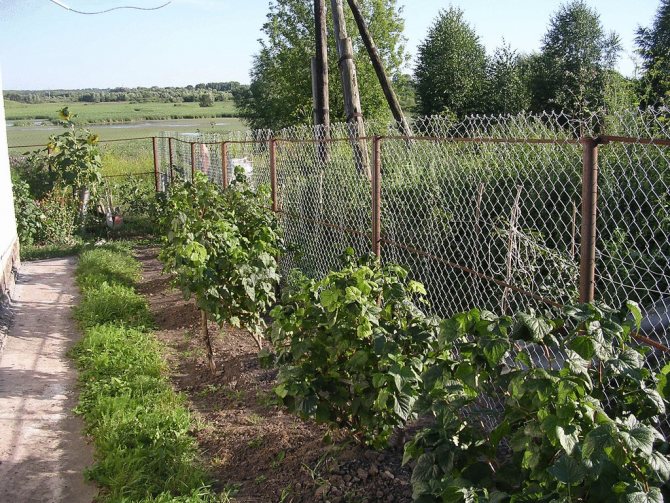

The culture grows on different types of soil, although it prefers loamy more. The main thing is that the site is fertile with acidity closer to neutral. There should be no waterlogging, but good hydration is necessary. Black currants can be planted in the garden among young trees. The bush will grow with its neighbors and will receive ideal diffused lighting.
In the wild, black currants can be found in river floodplains, in gorges among wild fruit bushes. It grows well in mountainous areas.
Time to board


The best time to plant fruit bushes is autumn, around the end of September, mid-October. The soil still keeps warm, and before frost there is enough time to take root and prepare for winter.
Spring plantings are also acceptable, but less preferred. It is more difficult to choose the time, since you need to have time to plant the bush after the end of the frost, but before the start of the seasonal growing season. In this case, seedlings growing in containers will come to the rescue. Then the rooting process will take place faster and without stress for the plant.
Currant vegetation begins at a temperature of 3-6 ° C. The best temperature for growth is 18-20 ° C.
Soil preparation
The place where the black currant will grow begins to be prepared three to four weeks before planting the shrubs. To do this, remove all weeds along with the roots and, if necessary, level the area. Particular attention is paid to the growth of wheatgrass, currants do not like it very much.
The soil is dug up to 30 cm, having previously scattered 5-8 kg / m2 of organic fertilizer (ready-made humus or compost), 3-4 tbsp. phosphoric and 1.5-2 tbsp. potash fertilizer. Usually they take phosphate or superphosphate, potassium sulfate or ash (40 g / m2). The main thing is the absence of chlorine.
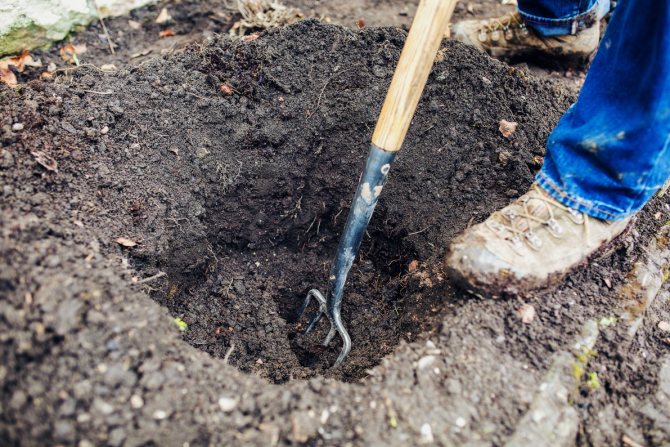

If the land on the site is depleted, the amount of fertilizer is increased by one and a half times, for fertile, on the contrary, it is reduced by half. Acidic soils (Ph below 5.5) must be limed by adding 400-500 g / m2 of lime during autumn work. Such preparation of the soil is necessary for both autumn and spring planting of a black currant seedling.
Blackcurrant planting process
The culture is planted in a pre-dug hole 40-50 cm deep and about the same diameter. The pit is filled 2/3 with fertile soil, poured half a bucket of water and the seedling is placed in it vertically or at an angle of 45 ° - it is better to do this work with an assistant. It is necessary to ensure that the depth of the seedling is 5-7 cm above its root collar.
At what angle to plant - it is up to the gardener to decide. But inclined planting promotes intensive root growth and the formation of a large number of annual (zero) shoots. The bush becomes more powerful.
When planting, the roots of the plant are carefully straightened and sprinkled with soil, carefully compacting it. Then a furrow is made around the bush, where the remaining water is poured. After that, the site is mulched with sawdust or peat.
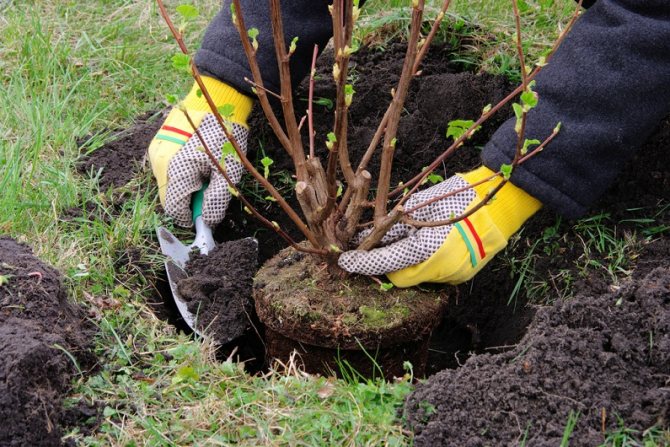

The planting technology is also preserved for spring work with the only exception: all branches of the seedling are cut off, leaving 2-3 well-developed buds on each shoot.
From the history of culture
Currant is a moisture-loving plant, in natural conditions it chooses moist forests, river slopes, lakes and swampy areas. Growth area - Eurasia, North America.
The ancient Greeks and Romans did not know the type and taste of currants. Wild species of it grew at that time on the lands of Central and Northern Europe: the shrub better tolerates temperate climates and even cold ones. He does not like heat, subtropics.
In the 15th century, currants began to be massively cultivated in France, and then in Germany. The first species that Europeans met is red currant. They paid attention to the black variety a little later.
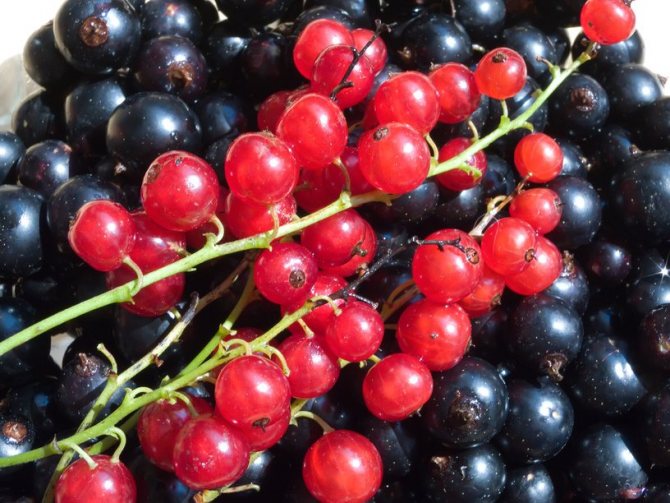

Currant diversified the lean meals of monks in Russia in the Middle Ages
The first written evidence of the existence of currants in Russia dates back to the Middle Ages. However, in the Kiev monasteries, culture was cultivated as early as the 11th century. Monks moved currant bushes from the forests beyond the fence of the monastery grounds.
In the gardens of Pskov, Novgorod and young Moscow at that time, currants were also found. Simultaneously with other berries, it was transferred from the forests to the princely lands.
The banks of the river on which Moscow stood were covered with currant thickets. In this regard, the river was nicknamed Smorodinovka (now the Moscow River).
By the 18th century, currants (especially black currants - Ribes nigrum) won special respect among domestic fruit growers. But now culture is losing its popularity. Currant plantations are being replaced by other berry bushes.
Answers to frequently asked questions
- When currants are placed in place with a predecessor from vegetable, flower plants, the planting will be provided with nutrients for a sufficiently long time and will bear fruit better, since it will be located on non-depleted soils.
- It is not recommended to plant a shrub on the site of a previous cultivation of gooseberries or currants, since the soils can get tired of monoculture and accumulate toxins in several years.
- For more active pollination of currants with insects, it is recommended to spray during the flowering period with a solution of 1 liter of water from 1 tbsp. l honey.
- It is recommended to plant currants in groups of bushes next to each other, rather than individual bushes, since in the first case, better pollination of the bushes is ensured, which increases their fertility.
Growing currants on a trunk
Standard growing of currants in our gardens is not very widespread. However, this method of cultivating a culture has many advantages:
- fruiting branches with berry clusters do not touch the ground, which significantly improves the quality of the crop;
- each branch receives a sufficient amount of light, which also has a beneficial effect on fruiting;
- the bush is less susceptible to attacks by harmful insects;
- easier picking of berries, as well as caring for the bush;
- compact plantings make it possible to save the area;
- caring for the trunk circle is greatly facilitated;
- the standard bush is superior in decorative qualities to an ordinary bush.
To create a standard bush shape, you can use two methods:
- rootstock engraftment on the scion;
- creation of a rooted stem.
The first method is suitable for those fruit growers who are well versed in garden "surgery", the second can be mastered even by novice gardeners.
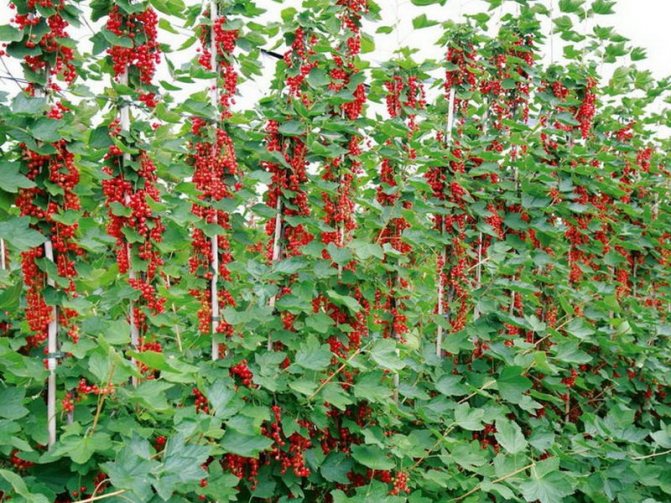

Whole alleys can be created from standard currants
Currant pruning


Spring currant pruning
Pruning currants is necessary, because during this procedure all unnecessary, injured, diseased and weak branches are removed, which means that the plant will no longer have to spend its strength and nutrients on them. Most of the ovaries are on last year's increments of four-year and five-year branches. In this regard, branches that are more than 6 years old must be cut out, because they are no longer needed. You also need to cut out diseased and dead branches. With timely and systematic pruning, the fruiting of black currant bushes can be extended up to 20 years, and red - up to 15 years.
In autumn, when leaf fall ends, the main currant pruning should be done. In early spring, before the buds open, the stems damaged by frost in winter must be shortened to healthy tissue, and all dead and injured branches must be removed.In the summer, it is recommended to pinch the ends of young shoots, this is necessary to stimulate their tillering, as well as to give the shrub a neat and regular shape.
Pruning currants in the fall
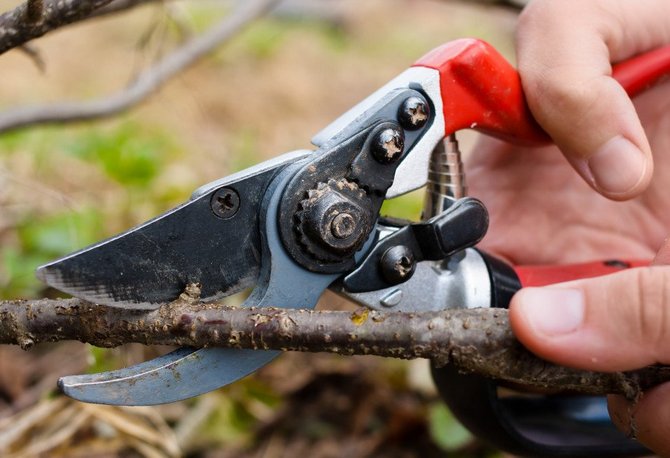

After the seedling is planted in open soil, all its stems are shortened to 10-15 centimeters from the surface of the plot. In the second year, the bush will need to choose 3-5 of the most powerful zero shoots, they will become skeletal branches, and the rest must be cut out. On shrubs of the third and fourth years of growth, you should choose from 3 to 6 of the most developed zero shoots, and the rest are removed. Avoid thickening of the bush, for this you need to remove weak and underdeveloped shoots in the middle of the bush. Trim the tops of last year's stems. Two- and three-year branches are shortened, while 2-4 buds should remain on each branch. If you cut the bush correctly and regularly, then by this age it will already be fully formed. In subsequent years, it will be necessary to cut all branches over 6 years old at the root. The pruning of the remaining branches is carried out according to the scheme described above.
Rules for pruning white and red currants
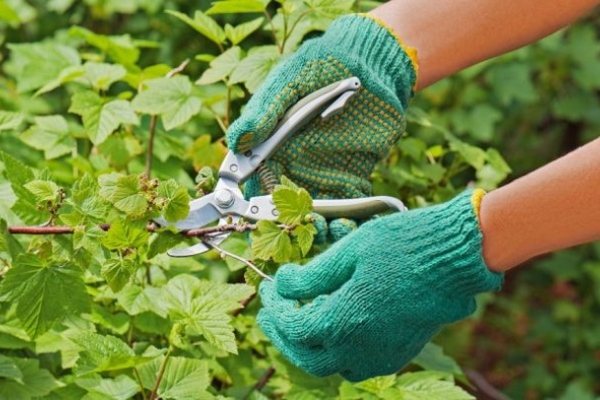

Pruning of white and red currants is carried out in the spring. The rules and pruning schemes use the same ones that are intended for black currants, however, pinching the tops of the growths is not necessary, as well as shortening the shoots of the second and third years. You will need to cut out all old branches that are more than 7 years old, and you also need to remove all unnecessary young shoots, injured and diseased branches. In the event that a branch over 7 years old continues to bear fruit, then it should be shortened to the nearest powerful fork. In this case, she will live and bear fruit longer than usual.
Autumn after harvest
It is especially important to properly grow and care for currants in the country after harvesting. Autumn care comes down to performing procedures to prepare the entire plant for wintering. The set of procedures must necessarily include: cleaning fallen leaves, complex feeding, pre-winter watering and plant warming.
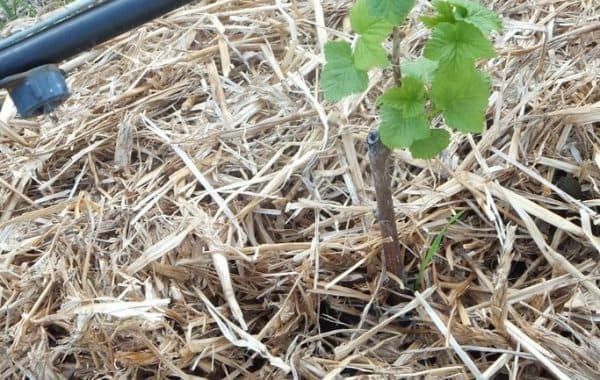

Using mulch increases yields by 40%.
Loosening and mulching of the soil
Loosening of the soil is started only after thorough cleaning of the soil around and under the bushes from weeds, fallen leaves, old mulching composition. The soil is not loosened deeply - 5-7 cm from the soil surface. The layer of new bulk mulch should not be <15-20 cm.
Top dressing and fertilization - pest and disease control
After a season of active growth and fruiting, currants especially need a sufficient amount of phosphorus, magnesium, potassium. Before replenishing the reserves of these microelements in the soil layer, the soil should be disinfected with environmentally friendly means. If the currants were sick during the growing season, then strong drugs should be used for disinfection. As an autumn mineral feed, they use: superphosphate, potassium chloride.
Watering
Autumn watering is performed twice: 1st - immediately after harvesting, with a volume of 10-20 l / under a bush, 2nd - in late autumn, moisture-charging, pre-winter, with a volume of 40-50 l / bush. Podzimny watering is carried out after complete fall and harvest of the foliage, before the onset of frost.
Pruning
In early autumn, branches of all types of currants are cut:
- bent over, lying on the ground;
- intertwined;
- poorly fertile;
- irregular shape, deformed;
- sprouted far from the bush.
Late autumn is a good time for rejuvenating pruning. Shrubs need it from the 6-7th year of growth.
In the case of a strong thickening of the old shrub, the rejuvenating procedure is carried out in several years, because the old plant may not survive the simultaneous loss of a large amount of vegetative mass.
Currant - a universal berry
This berry is familiar to everyone from childhood, but few people know its botanical description.For a gardener, this information will be quite interesting. So, currants are a whole genus of perennial shrubs that belong to the Gooseberry family. It unites almost 200 species, of which about 50 are widely distributed in nature in Asia, North America, and Europe. A huge number of wild species of this berry shrub is found in the Siberian region of Russia, and only 3 of them grow in the European part of the country.
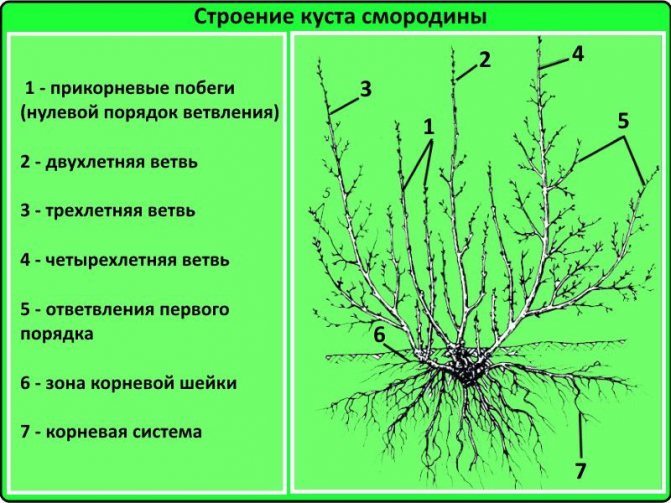

The structure of the currant bush
Currant is a shrub with shoots up to 2 m high, richly decorated with carved lobed leaves of 3-5 lobes of rather large sizes (up to 12 cm). The color of the leaf plate is dark green on the outside, and lighter on the inside, with a light edging along the veins. Currants bush very well, because every spring more and more young stems appear from dormant buds.
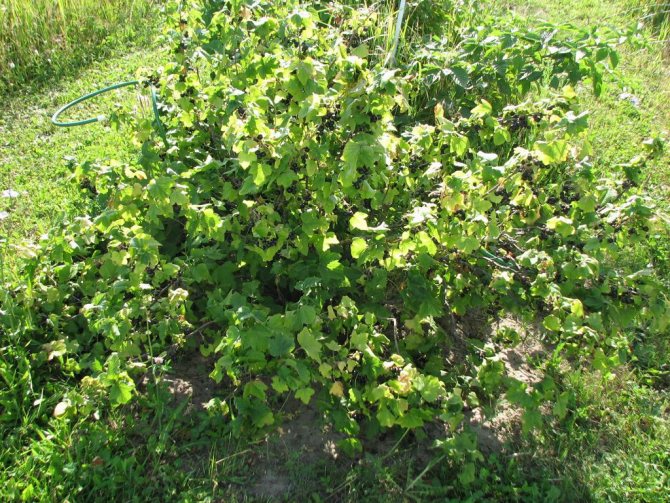

Black currant on the site
On a note! Currant leaves have a special aroma that is familiar to everyone. That is why they are often dried and added to tea and seasonings. And the aroma is emitted by special golden-colored glands located along the edges of the leaf plate.
The root system of the currant bush is fibrous, rather lush, penetrating deep into the ground by about 20-60 cm.Currant flowers are small bell-shaped buds, each having 5 sepals and collected in racemose inflorescences of several pieces, which can have a different color, including white , red of different shades, pink, yellow. The flowering period begins in May-June and lasts until June-July, although, depending on the region, it may start later and will also end later.
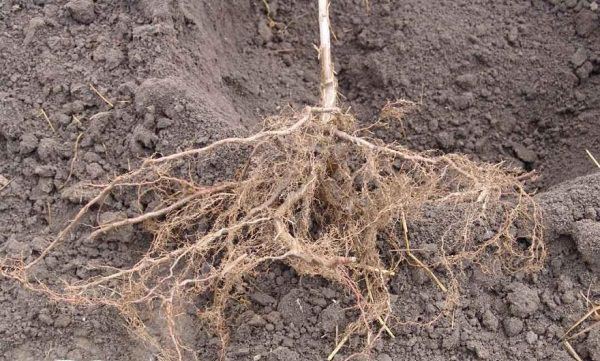

Currant root system
The fruit is a very juicy and aromatic round berry. Its color and size directly depend on the type and variety of the bush, and the taste can be sour or sweet-sourish. The color of the fruit varies from transparent white to black, it is red, yellowish-golden. Fruiting begins around July-August, while about 2 years should pass from the moment the currants are planted in open ground.
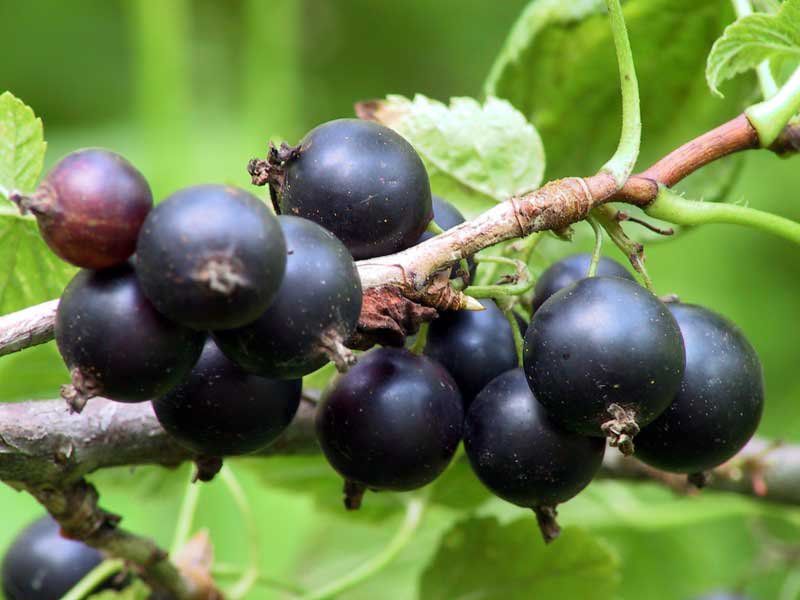

Currant fruits
Currant is one of the most popular horticultural crops, which is grown in garden plots along with gooseberries, strawberries, raspberries. It owes its popularity not only to its unique taste, but also to other properties. It is very useful as it contains a lot of vitamins and minerals necessary for health. Various dishes are prepared from this berry, added to teas and decoctions, natural food colorings are made on the basis of blackcurrant juice.
Currants are also used in folk medicine for the prevention of diseases of the circulatory and nervous systems, as well as malignant tumors, diabetes, and visual impairment. It has a positive effect on mental abilities, fights varicose veins, and is effective in kidney diseases.
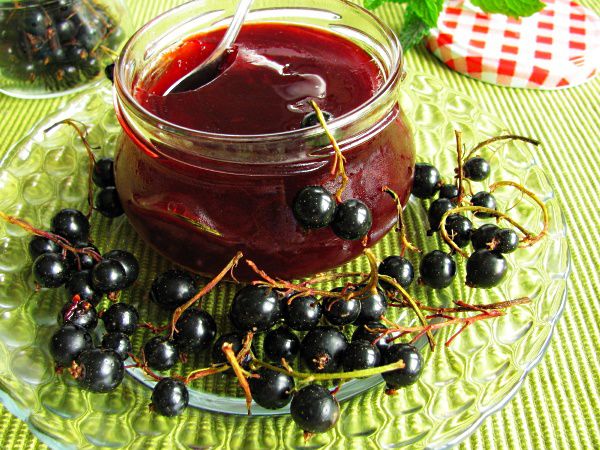

Currant tea is not only tasty, but also healthy
On a note! Due to its enormous economic value, currants are grown not only in summer cottages, but also on an industrial scale. And the largest producer of this berry in the world is Russia.
How to choose seedlings?
Choose a variety taking into account frost resistance and winter temperatures in your region. If planting is carried out in central Russia, varieties with frost resistance of minus 40 degrees are chosen.
Rules for choosing seedlings of golden currant:
- The recommended age of the seedlings is 2-3 years.
- The seedling should have 3-5 main roots, 20 cm long, and developed fibrous roots. There should be no dried or rotten roots, traces of diseases or pests.
- It is desirable that there are two shoots 30-40 cm long. The bush should be intact, without cuts and broken branches.
- Planting material that has been lying in the sun all day is not suitable - the bushes may not take root.
- When transporting seedlings, the roots are wrapped with a damp cloth. If the ends of the roots are damaged during transportation, they are carefully trimmed.
It is advisable to buy seedlings only in special nurseries and centers involved in the cultivation and sale of planting material.
How to propagate a culture?
There are no problems with the reproduction of golden currants - the plant is easily propagated by any of the existing methods.
Breeding methods for golden currants:
| Breeding method | How to do it? |
| Seeds | This method is not recommended. Saplings grown from seeds do not inherit varietal traits. |
| Cuttings |
|
| By dividing the bush | In spring or autumn, a bush is dug up and the rhizome is divided into several parts. The separated parts are planted in prepared pits. |
| Layers | In the spring, a two-year-old shoot is taken on the mother bush. A shoot is dug into the furrow, leaving the top 20 cm. Having fixed it, it is grown until autumn, then transplanted. |
Cuttings harvested in the fall for spring planting are "canned" for the winter:
- The sections are immersed in melted paraffin.
- The branches are wrapped in wet wipes and placed in plastic bags.
- The bundles are placed under the snow - until spring.
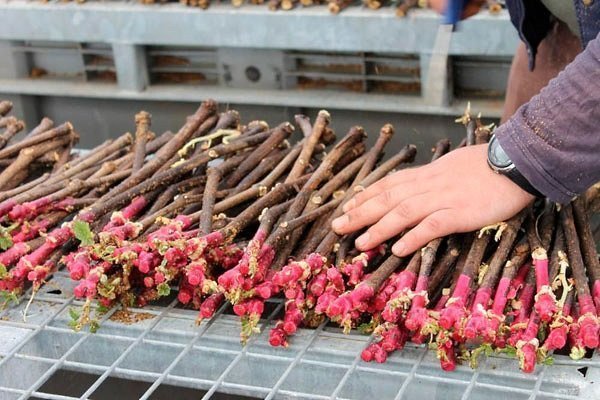

Golden currants, unlike red ones, are not propagated by vertical layers.
The main diseases of currant plants
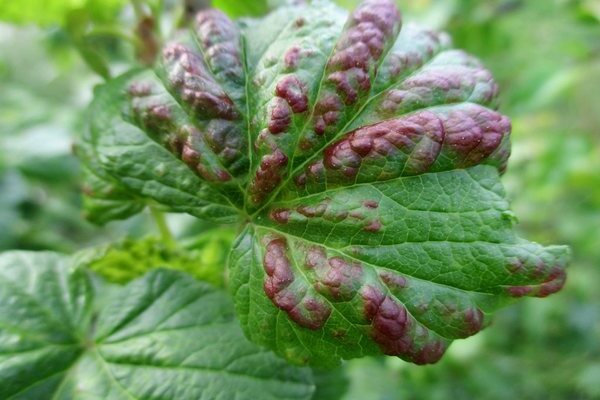

Currants often have the same diseases and pests as other garden bushes. Most often, the disease appears when the wrong care is taken for the shrub.
The currant plant most often suffers from diseases such as:
Anthractosis - with this disease, convex brown spots appear on currant leaves. Over time, they increase and quickly join together, which is why the leaves simply dry out and fall off. The disease begins to spread from the bottom of the bush and gradually creeps higher.
Septoriasis - with this disease, round brown spots first appear on the leaf, gradually they brighten and whiten, and a brown border remains around the spot itself. Gradually, this disease can also affect the berry.
Goblet rust Is a fungal disease. On the leaves of the currant, there are some kind of orange "pads" in which there is a fungus, which develops rapidly.
Terry - with this disease, purple double flowers appear on the bush. Also, on young layers, the leaves darken and stretch. Gradually, all the foliage on the bush darkens, and it loses its aroma and stops bearing fruit.
Gray rot - this disease affects many plants. Initially, brown spots appear on the leaves, which gradually affect the wood as well. The bush begins to wither and gradually disappears altogether.
Columnar rust - with this disease, small yellow spots appear on the leaves, and growths appear on the opposite side of the leaf. In these growths, spores of the fungus sit, which over time infect the entire bush, destroying it.
Necrosis of stems and branches - with this disease, the bark of the plant becomes too dry, gradually cracks and dries up. Accordingly, the bush dies very quickly.
Striped mosaic - this disease very often spreads in the summer. At the same time, a kind of yellow pattern appears around the veins on the leaf.
Powdery mildew - this disease affects many plants in gardens. A white bloom appears on the leaves and fruits, it gradually moves to another stage and becomes a brown film, after which the fruits simply begin to rot.
Nectric necrosis - this disease most often occurs in red and white currants. The branches of the bush with this disease simply dry up. This is a viral disease, which is not always possible to get rid of. This is because 100% of the cure for it has not yet been invented.
And if you do not start to treat this disease in time, then you can easily lose half of the bushes in one season. Therefore, it is best to carry out prevention and with proper care, the disease practically does not appear.
Also for the prevention of this disease, the most effective drugs are: Bordeaux liquid, Copper sulfate, Nitrafen and Karbofos. Spraying with these solutions of these preparations should be carried out in early spring before flowering and in autumn after harvest.
Description of the red currant shrub
According to the description, red currant bushes are very similar to black. Bushes can be of different sizes: tall ones reach 2.5 m in height, low-growing ones - less than a meter. There are varieties of very small sizes - their height does not exceed 60 cm.
Red currant bushes form a relatively large number of strong basal shoots. The productive period of each branch lasts up to 8 years, which is due to the life of the fruit formations.
After that, the number of fruits on it is significantly reduced. Fruiting can occur on the growths of the last year, but most of the harvest is formed on perennial fruit formations: bouquet twigs and ringlets. Fruit formations are formed crowded in the upper parts of last year's increments.
As you can see in the photo, the flowers of red freedom are yellowish, of different lengths, collected in an inflorescence-brush:
Almost all varieties are self-fertile, that is, they do not need additional pollination. Fruits can vary markedly in size and are white, yellowish, pink, red or nearly black in color.
A flowering currant bush, of course, cannot compete, for example, with an apple tree, but it looks attractive. But fruiting allows you to appreciate these plants.
Red currant berries can hang on bushes for a long time without losing their qualities. In fairness, it must be said that there are few ornamental shrubs that can decorate the garden during its fruiting.
The most expressive varieties of currants with different colors of fruits, planted next to it, will look. It is good to use plentifully fruiting varieties with a long brush.
Here it should be added that the autumn color of the leaves in varieties with red fruits, as a rule, is red-burgundy, and in white-fruited varieties, it is yellow. When choosing varieties, one must not only be guided by the color of the fruits, it is important that they are similar in strength of growth.
The next section of the article describes how you can propagate red currants in your garden.
The main pests of currants
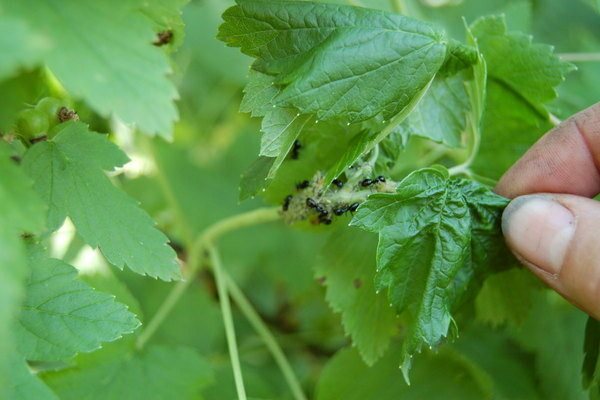

Also, currants have insect pests. Because of them, you can easily lose not only the seasonal harvest, but also completely your bushes.
Pale-footed sawfly - these are caterpillars that completely eat up the foliage, leaving only the veins. And accordingly, if there is no foliage, then there will be no berries.
Biennial leaf beetle - these are caterpillars that harm not only the fruits, but also the buds of the bush, eating them completely. This pest appears not only on currants, but also on other berry bushes.
Yellow sawfly - these caterpillars completely eat up all the foliage. The priority for this insect is white and red currants.
Fire - if this pest has infected your plants, then the berries begin to sing very quickly and dry up just as quickly right on the bush. To prevent this pest from starting on your site, it is best to carry out prevention, because it will be quite difficult to get rid of it.
Sprout aphid - this pest is also an insect, it draws juices from the plant through the leaves. At the same time, they begin to quickly curl and dry, the shoots grow curved, or even stop growing altogether.
The bush stops in its development, over time, completely affected by aphids. If you do not get rid of it during the time, then you can be left completely without currants. And also aphids very quickly infect all plants in the garden. And given the stages of its development, it will easily get to neighboring areas.
Moth - this is a butterfly, the caterpillars of which completely eat up the foliage of not only white and red but black currants.
Red-gall and gall aphids - this insect in just one season can give up to 7 generations of offspring. Basically, this pest settles on white and red currants. From this insect, the bush turns yellow, the leaves begin to curl, begin to swell and gradually fall off.
Spider mite Is an insect that can harm not only red and black currants, but also other tasty and healthy berries. When a bush is affected by a tick, the leaves become marbled in color, begin to dry out and fall off.
Kidney mite - this pest gnaws the buds of the bush, and settling in them easily tolerates the winter, and in the spring it begins to eat them away completely.
Glass-maker - these caterpillars are easily able to get inside the branches of the bush and completely eat them out from the inside. Accordingly, after this, the bush immediately dies.
Gall midges - these pests have three types: Shoots - they eat away the branches of the bush from the inside.
Floral - these insects appear during flowering and feed on buds. After which the buds turn yellow and dry out.
Leafy - this type of insect gnaws holes in young leaves. Moreover, when these insects hit the berries, they, in turn, change their shape. You need to start fighting this insect at the moment when they just appeared.
To get rid of it, there are many both folk remedies and chemicals. You can also rid your currant bushes of this insect by carrying out prevention. Processing currant bushes in spring and autumn with copper sulfate or Bordeaux mixture.
Introduction
In our climate, several dozen types of currants can be grown. These include both wild and domesticated species. The greatest variety of wild-growing currants is observed in mountainous regions: in the Caucasus and the eastern Urals. In addition to traditional red and black currants, there are also white and golden currants. However, it was black currant for its taste and useful properties that occupied the palm of popularity.
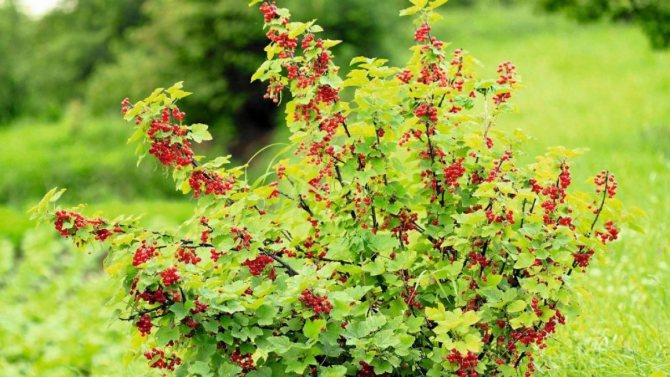

Red currant bush
Currants can be eaten raw, excellent jams, compotes, jams, syrups and so on can be obtained from it. Since currants have enough sugar and are fermentable, a variety of artisanal spirits are obtained from it, from wines and liqueurs to strong liqueurs.
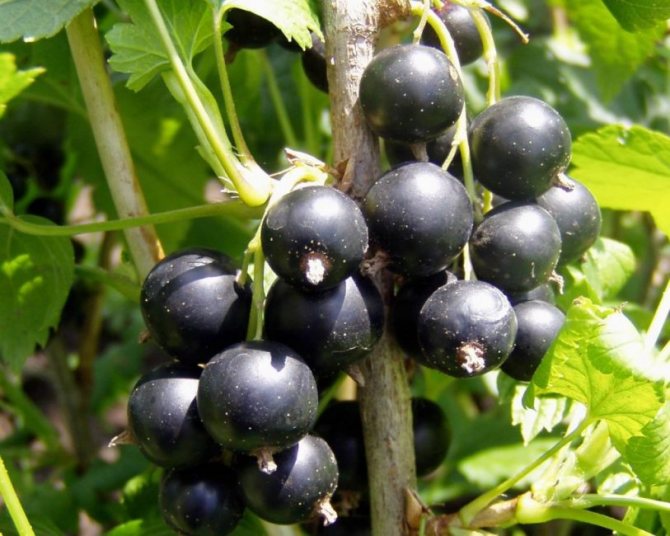

Black currant berries
The use of currants in medicine is primarily due to the presence in it of a huge amount of ascorbic acid (vitamin C)as well as flavonoids and tannins. Moreover, these substances are contained not only in the berries of the plant, but also in its stems and leaves. In folk medicine, various infusions, decoctions and teas are prepared from currant leaves and berries.
back to menu ↑
See also: Fast-growing perennial hedge: plant selection, planting, growing and care rules
The history of growing golden currant
Golden currant is one of the lesser known varieties of this plant. It comes from North America, from where it was brought to Europe in the 18th century. Initially, it was grown only in the botanical garden - at the beginning of the 19th century, only one variety was cultivated called Krandal.
Active work on the selection of other varieties of golden currant began under Soviet rule. During the search for drought-resistant plants for the construction of protective forest belts, it was discovered that golden currants are excellent for these purposes. Therefore, the plant in the 30s of the last century spread over the territories of Siberia, Altai, Ukraine, Kazakhstan, Uzbekistan.
The currant began to be called golden because of its beautiful bright yellow flowers with a pleasant smell.
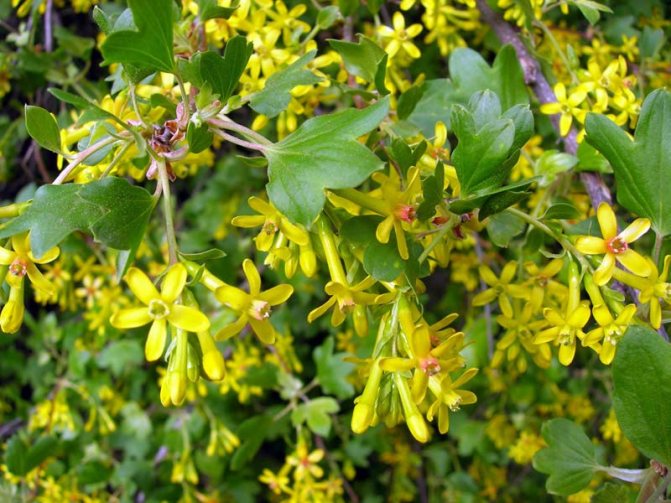

Golden currant bushes are very decorative thanks to their beautiful yellow flowers.
After a break in breeding due to the war at the end of the 40s, the Institute named after V.I. Shreder (Tashkent city). About 20 new high-yielding varieties were obtained, which served as the basis for breeding work in Russian scientific institutions:
- Elixir,
- Uzbekistan,
- Kishmishnaya,
- Muhabbat,
- Sun.
Reproduction methods
Currants are propagated in several ways.
Layers
Propagation by horizontally spread layers is a frequently used method. Any method involves the use of strong and healthy currant bushes as a mother. The advantages of this option are that the shoots root easily with minimal effort of the gardener, and the mother plant does not experience significant stress.
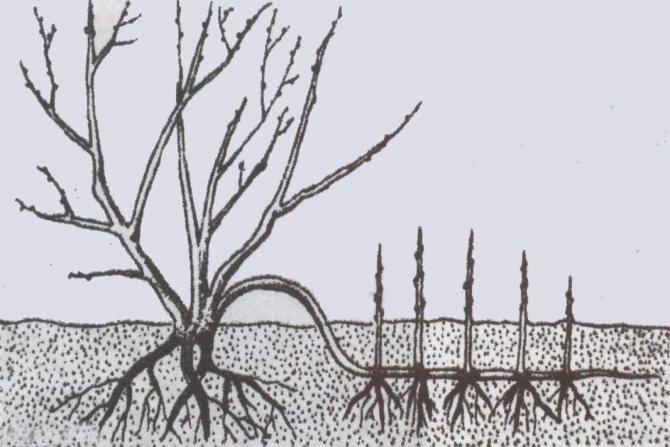

For propagation of currants by layering, one of the one-year-old shoots is laid in a trench and pinned
For rooting, the layers are laid in early spring or early autumn.
- Grooves 10-15 cm deep are made next to the bush.
- A soft pillow of sand, peat, humus, compost is laid in them.
- For the cultivation of cuttings, strong one-year-old shoots or 2-3-year-old shoots with increments are selected. They are placed in grooves and pinned with hairpins.
- Branches from awakened buds will sprout up on the layer. When they reach a height of 10 cm, they are huddled, keeping 1-2 leaves free.
- After 2-3 weeks in the spring, the hilling of the shoots is carried out again. If this occurs in the fall, the shoots are detached from the mother plant and moved to their permanent growth site.
By cuttings
Cutting currant cultivation is suitable when there is already a successfully grown variety on the site that you want to propagate. It is more convenient to harvest the cuttings in early spring during the spring pruning of the bush.
- Cuttings are harvested from fully matured stems, the thickness of which is not less than 6 mm, and the length is about 15–20 cm. Cut obliquely at the bottom, and the upper cut is made straight, departing 1 cm from the upper bud.
- Before planting the cuttings, together with the preserved leaves, they are soaked in a biologically active solution with Epin, Novosil, Kornevin, aloe juice.
- The cuttings are planted at an angle, dropping the tip 3-4 cm into the ground, between the seedlings they maintain a distance of 15-20 cm.
- A part of the cutting with 2 buds is left free, the lower one should be in close proximity above the surface of the soil.
- In order for root formation to proceed effectively, the moisture balance in the soil must be constantly maintained. For this, the soil is mulched with a compost layer of 3 cm.
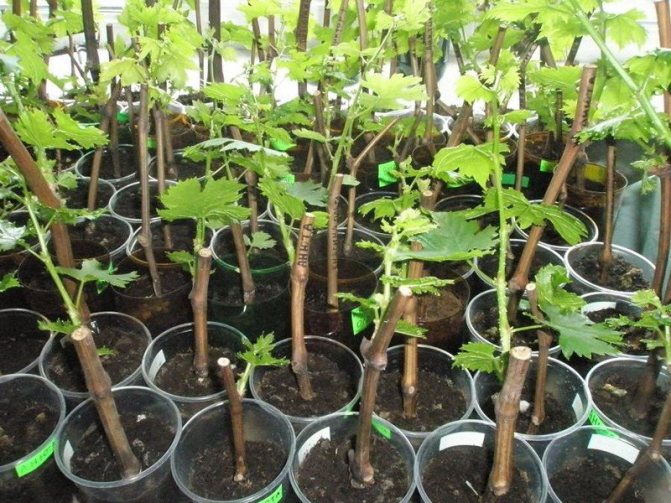

For better root formation, the tip of the cutting is powdered with a root growth stimulator
By dividing the bush
Reproduction of a bush by division is usually used when a valuable variety is forced to be transplanted to another place or when there is a shortage of planting material. The main advantage of this method is the quick survival of a newly planted bush without much difficulty.
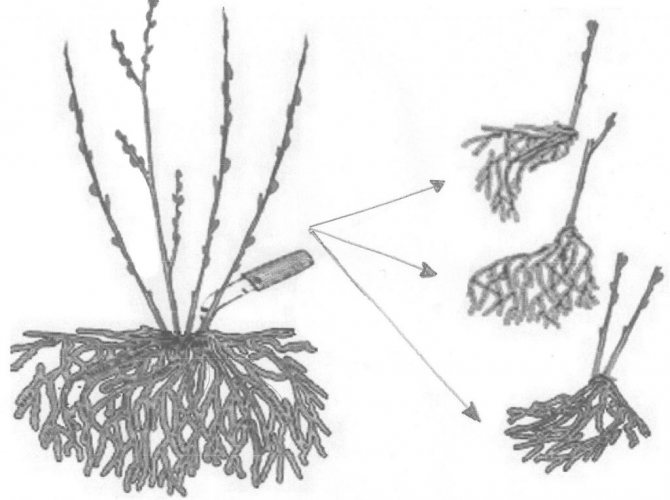

By dividing the bush, valuable varieties of currants are bred
Fashion technique:
- At the end of September and before the beginning of October or early spring, the desired part of the bush or bush is carefully torn from the soil, without damaging the roots.
- All old shoots are removed using a pruner or a garden saw, and the young are shortened to 30 cm.
- The bush is divided into 3-4 parts with a sharp hatchet. An important requirement is the presence of well-visible buds and a branched system of healthy roots on the part of the plant that is intended for planting.
- A bush is lowered into a hole (50x60 cm) fertilized with a rotted mullein. Its roots are covered with earth, which is tamped tightly and watered abundantly (1.5 buckets of water under the plant).
How to grow currants from seeds
Currants can be grown from seeds. However, you should not count on a quick harvest in this case.For the first time, a bush grown from seeds will begin to produce berries only in the 4-5th year of life. But even here a catch may await - the berries are likely to differ from those from which the seeds were taken. The technique is simple. Ripe fruits are cut, kneaded, washed gently, slightly dried.
It is initially permissible to dry the berries in a special vegetable dryer, after which it is already possible to get the seeds out of them.
Further, it is desirable to carry out stratification with seeds. Under natural conditions, this process resembles the situation when berries fallen from the branches spend the winter under the snow.
Stratification - keeping seeds of different crops at low temperatures up to 70 ° C to improve their germination. For this, the seeds are placed in a damp cloth or soil.
Currant seeds are used in different ways: they are sown in the spring (the method resembles the cultivation of vegetable seedlings) to obtain sprouts, they are placed in a cool cellar for storage until spring, or they are sown immediately in a prepared trench before winter.
What should be the seedlings
When choosing a planting material, you need to rely on its appearance and general condition:
- there are no signs of damage to the seedling by pests and diseases;
- the seedling is "fresh", as indicated by the green moist texture under the bark;
- the root system is developed, reaches a depth of 30-35 cm;
- the bark of the shoots is smooth, without wrinkled areas.
During transportation, the roots must be wrapped with a damp cloth or cellophane. You need to plant immediately, but if this is not possible, then you can temporarily dig the seedling at an angle into the ground and water it. So he can hold out for several weeks.
Varietal variety
Currant has not only many species, but also a wide variety of varieties, differing in growing conditions, yield and ripening times.
Among the entire abundance of varieties, you can always choose those that are suitable for a given type of terrain, climatic conditions and personal preferences of the owner of the site. Consider the classification of currant varieties depending on its ripening time:
back to menu ↑
See also: Garden jasmine: description, types, planting in open ground, care, pruning, reproduction (60+ Photos & Videos) + Reviews
Early varieties
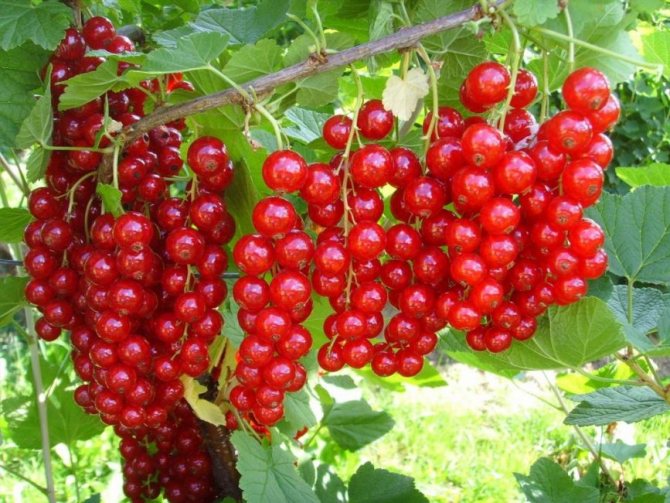

Jonker red currant variety
- Venus... Black currant, berry weight about 5 g. Tall bushes with sweet and sour berries.
- Pearl... Black currant with large berries, weighing up to 6 g.
- Ural white... Currant with white-yellow berries. Berries weight up to 5 g. Sprawling, branching bush.
- Jonker... Red currant with very large berries weighing up to 7 g. Sweet and sour taste.
- Umka... White currant. The berries are sweet, large. The bush is tall, not spreading.
back to menu ↑
See also: Saxifrage: description, types and varieties, reproduction, growing from seeds, planting in open ground, care (110+ Photos & Videos) + Reviews
Mid-season varieties
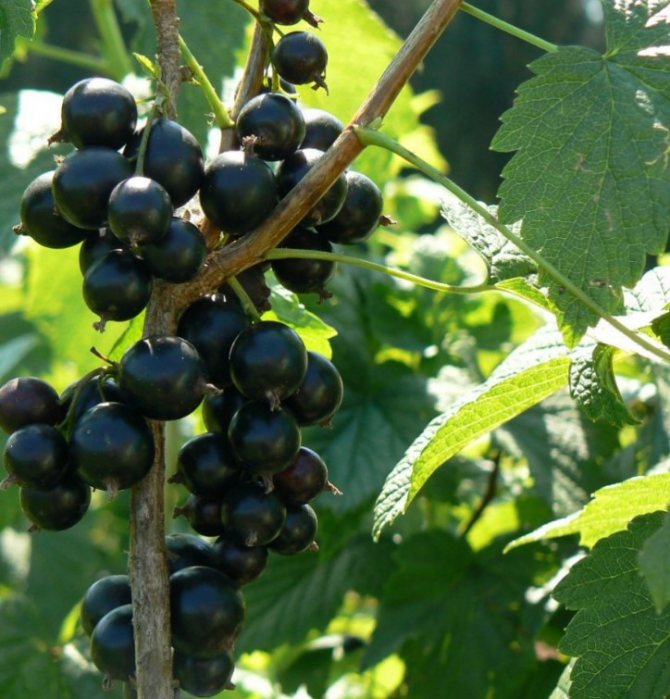

Sanuta variety
- Osipovskaya sweet... Red currants. Berries are large, up to 5 g. The bush is high, weakly branching. The berries are very sweet.
- Roland... Red currants. The taste is sweet and sour. The variety is resistant to disease and frost.
- Anniversary... Black currant. The bush is tall and compact. The taste of the berries is sweet and sour.
- Imperial... White currant. The berries are average 5-6 mm in diameter. The growth of the bush is average. The bush itself is spreading.
- Sanuta... Black currant, berries weighing up to 5 g. The bush is tall, compact.
back to menu ↑
See also: Potatoes: a description of the 73 best varieties + Reviews of gardeners
Late varieties
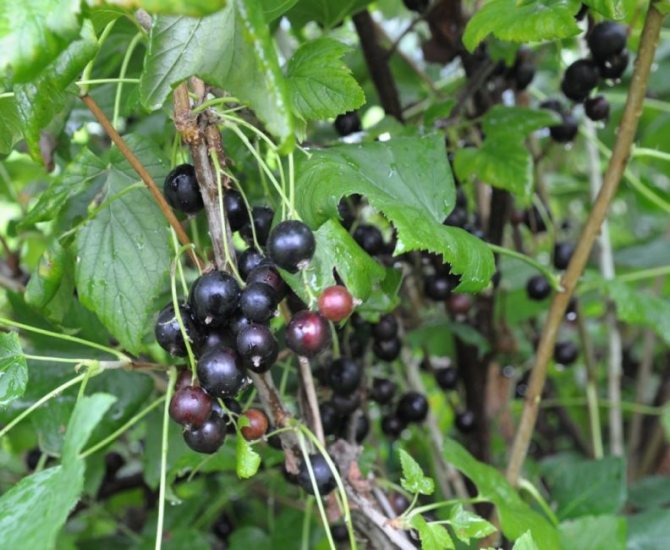

Lazy person
- Valentinovka... Large berries (up to 10 mm in diameter). The bush is high, not spreading. The berries are sweet and sour.
- Lazy person... Black currant Compact bush. The berries are sweet.
See also: How to create beautiful flower beds and flower beds in the country with your own hands? (220 fresh photos and video ideas) + Reviews
A few landscape tricks with currants in the garden
Group landings are best used either as a fence or as a central composition.All seedlings must have the same climatic requirements.
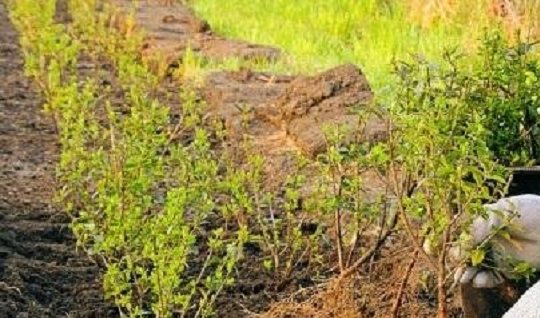

Smooth border lines are easy to achieve by planting an odd number of bushes
When equipping the park, they resort to a single landing. So that free-standing bushes can attract attention, a variety is selected that retains its colors for a long time, and seedlings are planted at a distance three times the expected height of an adult currant bush.
To visually hide the unevenness of the terrain, use the technique of multilevel compositions.
Currant bushes, planted along the paths, decorate the site better than flowers. These hedges bring identity to the garden.
You can give a hedge a showiness by combining in it several types and varieties of crops that have different colors of berries and flowers.
When grown on trellises, the plant is better illuminated, less likely to be affected by diseases, and looks more well-groomed and graceful.
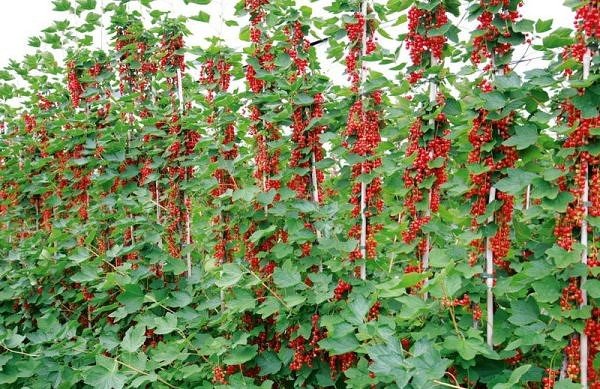

It is more convenient to pick berries ripened in summer from tied bushes.
However, this process takes a lot of time and nerves, so not every gardener completes the job.

